Loading...

Issue 111

Imaginations Real
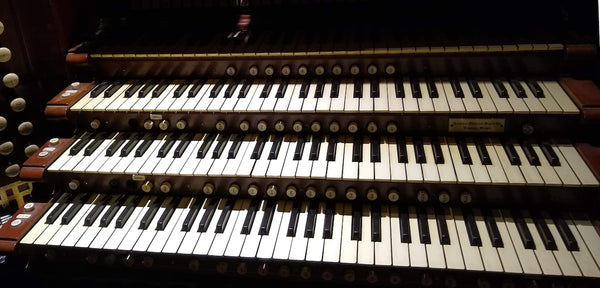
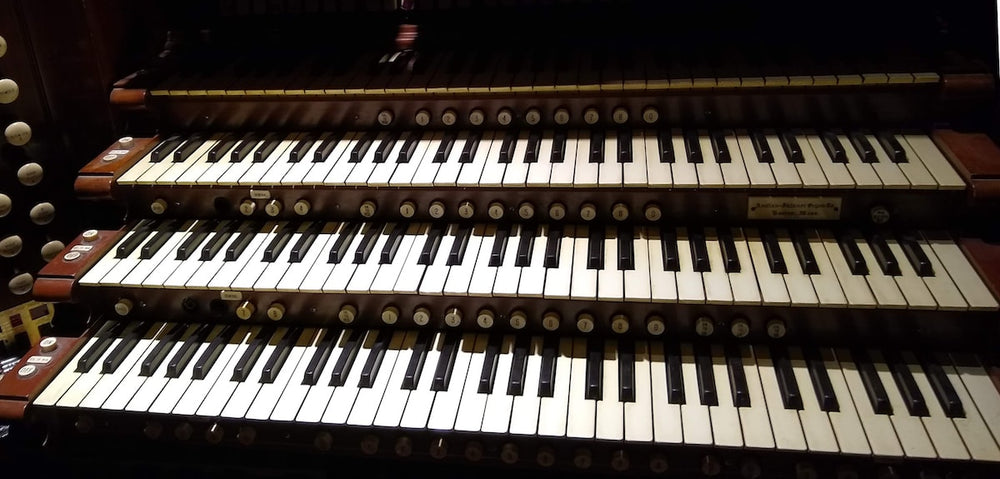
Breathing Restored Life Into a Classic Pipe Organ, Round Two
Calvary Episcopal Church was founded in 1836 and is part of the Parish of Calvary – St. George’s in New York City. A fixture in the Gramercy Park area for nearly 185 years, it is not only a landmark historic site of New York City but is also the acknowledged birthplace and American headquarters for the Oxford Group, which would later evolve into Alcoholics Anonymous.
In 1936, Calvary Church ordered a new pipe organ from the Aeolian-Skinner Company of Boston to replace their 1907 Skinner pipe organ, itself a rebuild of an earlier version of the Roosevelt organ originally built in 1886. The Aeolian-Skinner Opus 945 pipe organ retained 15 stops from the original Roosevelt model, which are still functional today. However, the organ itself has been deteriorating over the last 84 years, the result of age, neglect, poorly-executed repairs bordering on incompetence, fires, and damage from construction workers doing restoration work on the church building.
Here is a profile of the Calvary Church Aeolian-Skinner Opus 945: http://www.nycago.org/Organs/NYC/html/CalvaryEpis.html
Since that time, Calvary-St.-George’s music director, choirmaster and organist, the internationally acclaimed baritone Kamel Boutros, has been on a quest to update the organ to become functional in the 21st century. However, the challenge has been to do the work on a shoestring budget, given that the estimate to restore the organ currently stands in excess of 3 million dollars.

Copper Issue 61 covered the innovative workarounds devised by Kamel, which included solutions for mechanical keyboard latencies, damaged pipes, non-working stops, and temperature sensitive pipe tuning fluctuations.
Never satisfied in his quest, Kamel has continued refining the process, with the ultimate goal being able to have a full orchestra in combination with the ancient pipe organ at his fingertip command. The changes he has made since Copper Issue 61 cover both digital and analog modifications and improvements.
Creating an Actual/Virtual Cyborg Hybrid Organ:
The three most glaring playing challenges with Calvary’s Aeolian-Skinner organ are:
- Latency of varying milliseconds across all four of the keyboard manuals, making any kind of staccato playing virtually impossible;
- Temperature sensitivity of the metal pipes within the 200-year-old stone and wood church. The pipes can vary individually from A440 standard concert pitch anywhere from A427 to A442.
- Access to stops that were inoperable to blend with the ones that were still in use.
Taking advantage of the inherent natural acoustic delay and reverberation from Calvary’s 40-foot-high steeple and with the organ pipes mounted 20 feet above the pews along the altar perimeter and in the church’s rear near the entrance, Kamel had previously solved the problem by using the organ’s circa 1980s Peterson MIDI interface, which is limited solely to MIDI out on Channel 1 and only transmits note on/off data.
The deployment of the Hauptwerk Virtual Pipe Organ and its Notre Dame de Metz sample was Kamel’s initial solution, as the virtual organ had no latency and could thus provide the attack for the notes as the Skinner organ’s tones fleshed out the body of the notes. The Hauptwerk software also resolved the tuning fluctuation problems as the precise digital tuning could adjust to match the pipes for any particular climate condition. The software’s high cost (about $1,000) also is due to its unique capability to drive the actual organ pipes via MIDI. Finally, the software provided the missing Gallery, Great and Choir manuals/stop colors that the Skinner organ could not produce in its current state of disrepair.
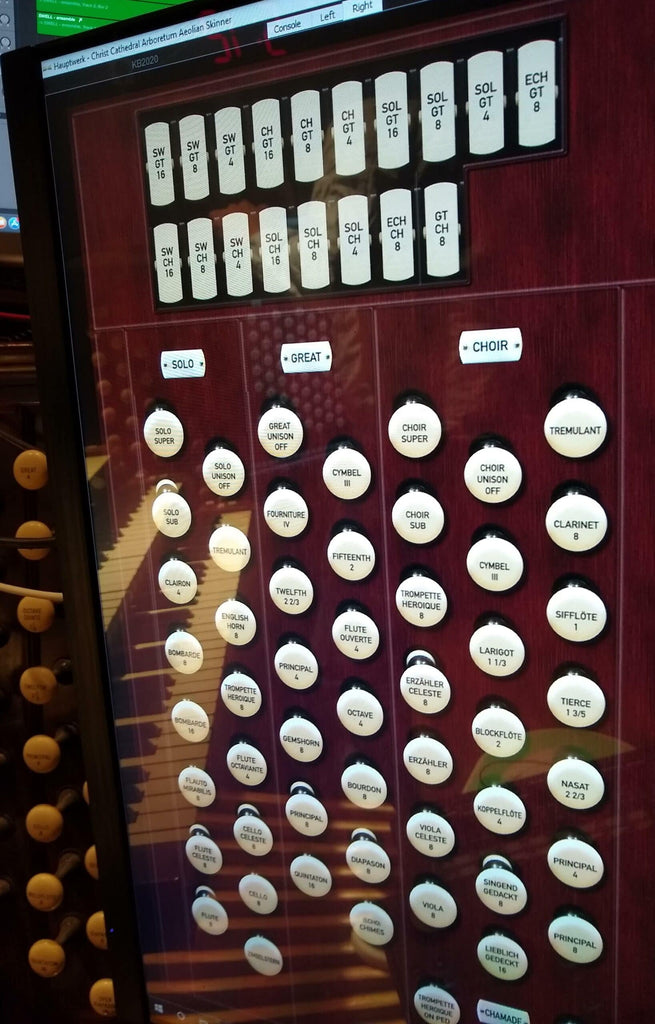
While Kamel had solved the most pressing mechanical issues, the Notre Dame sample was recorded in a space considerably larger than that of Calvary Church. Additionally, Notre Dame’s organ is a much more elaborately-featured instrument than the Aeolian-Skinner. Choosing uniformity and authenticity of sound over a more luxurious, albeit less than ideal accommodation, Kamel has since opted to switch the Hauptwerk software license to the CCARB, which is a sample of the pristine Aeolian-Skinner Opus 1141 pipe organ recorded at Christ Church Cathedral Arboretum in Garden Grove, CA.
Better matching between the virtual and actual Aeolian-Skinner organ sounds and controls was the first goal in Kamel’s plan to bring the Calvary organ back to fully functional status. Even if it was a “cyborg” hybrid, Kamel’s desire was to next incorporate the bass pedal sounds and other stops, along with other MIDI controlled sounds.
Kamel’s four-keyboard manual signal chain first runs from the Calvary Skinner organ, locked to a MIDI clock while the MIDI out is split between a Hewlett-Packard 2420 PC running Hauptwerk’s CCARB, and a MacBook running Spitfire Audio Eric Whitacre choir, Symphonic Strings, Hans Zimmer percussion and Logic Pro X software. His display monitors are all touch sensitive.

These MIDI signals are connected through a Korg Nanocontrol Studio MIDI controller and an Akai APC40 Ableton controller.
As Calvary’s Skinner organ bass pedal foot pistons were never retrofitted with MIDI capability, he has added a Behringer FCB 1010 MIDI controller (with custom mounting frame designed by church elder Jeremy Coleman) and a Studiologic MP113 velocity-sensitive bass pedal unit. The Behringer controller’s MIDI signal is separately fed to a Focusrite Scarlett interface and then to the CCARB software.
With Calvary’s Swell manual only 25% functional and the Gallery, Great and Choir manuals even less so, the CCARB software is crucial at the note origination level for fleshing out the missing overtones and recreating vital fundamental tones in the organ music repertoire.
Additionally, while all the basic Skinner stops in Calvary’s organ still function, Kamel cannot add any additional colors to the sound due to the pipe disrepair, so the CCARB is crucial for supplying 32-foot, 16-foot, 8-foot and 4-foot octave tones as needed.

To quickly switch between Logic commands and the variety of presets that may be utilized between the various Spitfire orchestral and choir sounds, Kamel has a pair of mini keyboards mounted above the organ manuals: an Akai LPK 25 and an iRig keys. A 61 full-sized-key Korg synthesizer sits next to Kamel’s personal Yamaha concert grand piano, which acts as a backup MIDI controller in the event that the Calvary organ suffers a mechanical or electronic mishap.

Expanding the Sound Cloud:
Kamel Boutros has said that a true church pipe organ, in his estimation, reverberates throughout the entire church, and should take advantage of the echoes and reverberations inherent in stone and wood structures. Its power should range from the low notes shaking the floor to the higher registers surrounding congregants in a cloud of sound. Ideally, the sound should be “rounder and bigger” rather than “louder.”
Somewhat counterintuitively, sets of matching speaker arrays and similar platforms often sound too directional and pristine, thus bestowing an artificiality to virtual instruments in a church space, especially with virtual organs playing with actual ones. This is also a major point of difference between re-creating the sound of a Hammond Organ’s Leslie rotating speaker vs. a pipe organ. The church pipes are designed to resonate and project within a particular church space, thus dictating their elevated placement within the church structure. The Leslie speaker, while possessing a rotating horn driver, is still focused from a specific sound source and is designed for projecting that sound regardless of the surrounding space. The Hammond’s relative portability compared with the fixed installation of a pipe organ in a traditional stone and wood church was a key selling point in its marketing to houses of worship located in non-traditional structures, such as auditoriums, gymnasiums, warehouses, etc.
In order to mesh the virtual sounds with Calvary’s organ pipes, an assortment of both PA and hi-fi speakers have been strategically placed throughout the nearly 200-year-old church, which is roughly 90 feet long, 75 feet wide, and 40 feet high at the steeple.
As Calvary’s wooden 32-foot pipes are still in disuse due to fire damage, Kamel has a pair of Mackie subwoofers – one placed in front of the organ near the altar for the low end and subsonic frequencies, and the other near the side pews under the choir loft.
A small powered 8-inch Behringer PA speaker, discreetly hidden behind the pipes mounted 20 feet directly above the organ, provides high frequencies to the congregation’s right.
Directly opposite is the elevated choir loft, where two additional small Behringer speakers and a Peavey 12-inch wedge monitor resonate behind another array of pipes.
A pair of large JBL EON Series PA speakers are in the gallery, mounted about 25 feet high and situated over the entrance. A pair of 60 lb. 3-way Thiel CS2 home audio speakers from the 1980s are currently augmenting the JBLs, but may be relocated in the near future for better sound dispersion.
About 10 feet from the entrance is the FOH (front of house) Behringer X-32 mixing console and a rack for power amps, supplemental outboard gear, and a PC computer running Audacity software, which is used to record services.

The unorthodox placement and choice of loudspeakers effectively blend with the metal pipes in a seamless cloud of sound that challenges a listener to differentiate between the actual and the virtual.
Taking the model a step further, Kamel can now augment the live church choir with the Spitfire Whitacre choir software and also add an orchestral range of strings, woodwinds, brass and percussion instruments to the organ, creating a sound that would have been just as captivating over a century ago as it is today.
Conclusion:
With the rapidly diminishing number of organ parts manufacturers and qualified technicians, the costs to maintain or refurbish pipe organs have climbed astronomically. The 3 million dollar estimate to restore Calvary’s Aeolian-Skinner organ is on the low end compared to the average rate churches are facing globally.
While not a trained technician, Kamel Boutros’ love for the organ, a sound which held him spellbound as a child growing up in Cairo, Egypt, has out of necessity spurred him to educate himself in organ construction and design. This knowledge, combined with his studies in computer DAW and other music production technologies and an inventor’s imagination, has enabled him to keep his cherished organ sound relevant and expandable on a more humble church budget – a point of which other churches striving to keep their pipe organs in their music programs should take note.
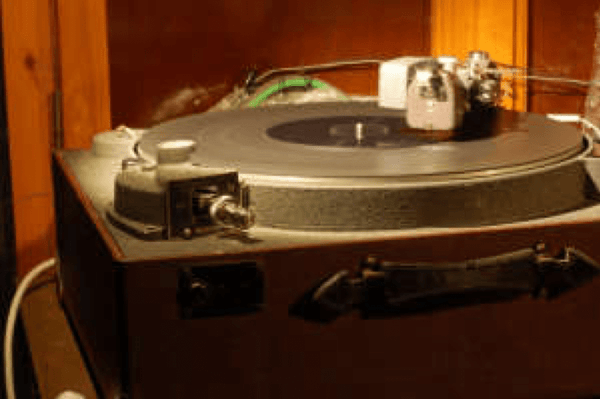
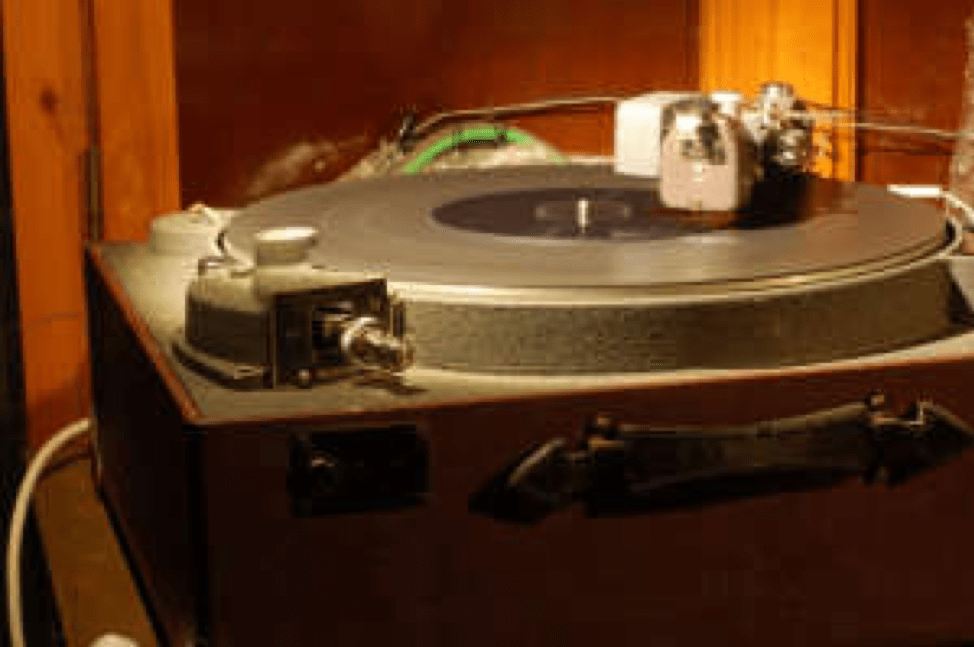
For the Record: Restoring a Vintage Disc Cutting Lathe

A customer recently imported a vintage Presto 75A disk recording lathe from the US, with a view to cutting records in Europe. [J.I. is based in Europe – Ed.]
He quickly discovered, like many people before him, that it was spinning a bit slower than it should, when operated from European 50 Hz AC via a simple step-down transformer. As with most vintage record cutting machines, the platter is powered by a synchronous AC motor, which “locks” to the line frequency.
The Problem with Industrial Inverters
He then tried to run it from an industrial inverter, a device similar to a phase inverter and intended for controlling the speed of industrial motors. The first issue with this is that such industrial applications do not normally require highly accurate speed control. The second problem is that inverters and VFDs (variable-frequency drives) are usually paired with motors designed to be powered by such devices – which don’t include cutting lathes! Their output is quite far from a pure sine wave and contains a lot of harmonics, extending to high frequencies. This tends to produce an audible whine from older motors and causes them to overheat, greatly reducing their performance and reliability.
When we tried to run the Presto from the inverter, the high frequency whine was even finding its way to the cutter head as electro-magnetic interference (EMI).
The inverter was promptly discarded and a new capstan was machined, to allow the motor to run from 50 Hz and still transmit the correct speed to the platter.

This process was described in more detail in this link. It was tricky, but we successfully converted the machine to run at an accurate 33 1/3 and 45 (instead of 78) rpm, connected directly to our EU mains.
A step-down transformer, a special version of our Type 1760, was designed and installed inside the lathe, to deliver the appropriate voltage to the motor for quiet and reliable operation without overheating.
Renewing the Wiring



There was a plate on the side of the lathe, that housed audio connectors. These were wired to a different standard than what is presently used by the audio industry. Some wires were cut, others were missing the insulation, and the wiring inside the machine had been badly bodged. It was a mess, even posing a safety hazard to the operator and equipment. The power cord was loosely coming out from a hole in the chassis, with the ground connection loose. We decided to remove everything and start from scratch.

We made a new plate to replace the old one. The new plate would accept an IEC power connector and mains fuse. There was no fuse anywhere on that machine when we got it! Since the metallic plate is only attached to the wooden frame, it also had to be reliably grounded. Similarly, all metallic parts of the machine were grounded.



On the other side of the machine, there was an ugly, butchered plate with electrical tape over it. Upon removing it and turning it around, it was discovered that this was a knob dial, pressed into service, from a machine manufactured by Cinema Engineering Co., of Burbank, CA. They used to also make disk recording equipment, but they are very rarely seen nowadays.


Next to it was a badly drilled hole with nothing in it. We enlarged the hole by civilized means, resulting in a properly round and smooth mounting hole for a fuse holder. A stainless steel round plate was made, with the Agnew Analog logo engraved in it, to hold a ¼-inch jack connector for hooking up the cutting amp.




The Mechanical Assembly: Inside-Out and Outside-In
With the wiring sorted, it was time to work on the mechanical assembly. This machine is very simple and elegant in this respect. A lever on the side allows the operator to shift between Inside-Out, Neutral and Outside-In cutting modes. This engages the cutting arm (or disengages it in Neutral) and defines the direction of the cut. Records can therefore just as easily be cut from the outer edge towards the center, or from the center towards the edge. Inside-out records were commonly used in the broadcasting sector. The practical significance was that if a recording was too long to fit on one disk, the sound would gradually change from the outer diameter to the inner diameter of the disk, and the sonic transition from the end of the first disk to the beginning of the next would be too abrupt. By recording the first disk outside-in and the second one inside-out, the abrupt sonic transition was eliminated.

The platter shaft has a worm gear at the top which engages the central geared portion of a horizontal shaft:
 A bronze rack is attached to the cutting arm, while the horizontal shaft and its base are attached to the Direction-of-Cut lever. In Neutral, there is no contact between the horizontal shaft and the rack:
A bronze rack is attached to the cutting arm, while the horizontal shaft and its base are attached to the Direction-of-Cut lever. In Neutral, there is no contact between the horizontal shaft and the rack:  When the lever is moved to the "Outside-In" position, one of the worm gears at one end of the horizontal shaft meshes with the rack teeth and advances the cutting arm inwards:
When the lever is moved to the "Outside-In" position, one of the worm gears at one end of the horizontal shaft meshes with the rack teeth and advances the cutting arm inwards: 
When the operator shifts the lever to the "Inside-Out" position the other worm gear meshes, advancing the cutting arm outwards:

The central portion of the horizontal shaft remains permanently meshed with the worm gear on the platter (vertical) shaft. The rack ends shortly before the inner and outer limits of the cutting arm travel, disengaging from the worm gear, to prevent "crashes." Two end-stops limit the travel of the cutting arm so it does not collide with something expensive, if manually pushed all the way to the end.

Fixed-Pitch and Double-Groove Records
With this design, the machine is limited to fixed-pitch operation, at 96 LPI (lines per inch) However, due to its intelligent design, the pitch is highly accurate. There are no grouping effects whatsoever. As it is also a rather coarse pitch, it leaves plenty of room to cut double-groove records, where a different song plays each time you put the needle down on the record depending on where it happens to land!
One would really have to try hard to break this machine. With proper maintenance it works like a horse!
As with all precision instruments, the 75A requires careful adjustment to run well. The horizontal shaft was sorely out of adjustment, causing noise. Someone had filled up the main bearing with grease…! Please, never use grease on precision mechanical instruments, unless the manufacturer explicitly calls for it. It may work fine for crude and primitive tools for the farm, but it has no place in precision lathe bearings, which are usually designed for a particular type of light machine oil.
The presence of the correct oil in the assembly is as important as any of the solid parts! Consider the oil as part of the assembly. The lathe won’t run as intended without it!
In the absence of the original specifications, the type of oil can be calculated by measuring and calculating the clearances, load, speed, temperature, friction, materials, accuracy required, and several more factors. This is best left to a qualified mechanical engineer with experience in machine tool design, but also well versed in the particular application of disk recording.
Fortunately, the manual for this lathe specifies the lubrication procedures, so we do not need to reinvent the wheel. We can supply all the lubricants specified, if required.
The Interesting Little Details
 The Presto badge is particularly noteworthy on this machine, resembling a record.
The Presto badge is particularly noteworthy on this machine, resembling a record.  Also noteworthy is the fact that this machine has matching serial numbers on all parts, proving all parts to be original, as fitted by the factory:
Also noteworthy is the fact that this machine has matching serial numbers on all parts, proving all parts to be original, as fitted by the factory: 


Many disk recording lathes have an oil dashpot for damping the suspension. Others have an advance ball system, a mechanical means of controlling and regulating groove depth, while others have nothing at all.
The 75A, being marketed as a portable machine, came with a “dry” dashpot:

 This is the Presto 171-A damper, especially suitable for portable systems, as there is no oil or other liquid to spill and make a mess!
This is the Presto 171-A damper, especially suitable for portable systems, as there is no oil or other liquid to spill and make a mess! 
It is a very heavy brass casting, suspended on a reed spring, damped heavily, and tuned to counteract the vertical oscillation tendencies when cutting lacquer disks with a Presto cutter head.
Don’t laugh, it actually works!



 This machine was in need of a cutter head, so we paired it up with an RCA MI-4889, a moving iron design, also dating from the 1930's.
This machine was in need of a cutter head, so we paired it up with an RCA MI-4889, a moving iron design, also dating from the 1930's. 


These heads are quite sturdy and can sound good if used with due care.
A friend of the owner got excited about all this and built a custom cutting amp with built-in RIAA pre-emphasis:
 As a final touch, we made a custom mount for a microscope stand to fit the chassis. A very basic groove and stylus inspection microscope is thus provided, which is essential for adjusting cutting parameters, troubleshooting and inspecting the final product.
As a final touch, we made a custom mount for a microscope stand to fit the chassis. A very basic groove and stylus inspection microscope is thus provided, which is essential for adjusting cutting parameters, troubleshooting and inspecting the final product. 
The result is a fully restored, fully functional disk recording lathe that will take any blank size from CDs to 16-inch blanks and will cut or emboss. CDs are the cheapest, easiest and most widely available material that grooves can be cut/embossed onto with acceptable fidelity and have found widespread use among users of vintage disk recording lathes. In some cases, the same CD can then be played back both in a CD player and on a turntable!

The performance is very good for its age and it can even cut master lacquer disks, within its operational limitations. It is portable, reliable and easy to set up, making it the ideal system for mobile recording and events.
This machine was deemed to fulfill the notoriously high performance expectations of the British Broadcasting Corporation and was widely used in various BBC studios. It was commonly installed in sturdy, floor-standing cabinets. Two of these can be seen side by side in an installation in Aldenham, in a photograph dating from 1949, on Plate 6, between pages 106 and 107 of the BBC Recording Training Manual, published by the BBC in 1950. A close-up of the speed selection lever appears as Fig. 97 on page 108.


This article was originally published on the Agnew Analog Reference Instruments website, www.agnewanalog.com.


Where Cool Water Flows
The Cart Creek Bridge at the Flaming Gorge National Recreation Area in the eastern corner of Utah. The water is part of the Green River.
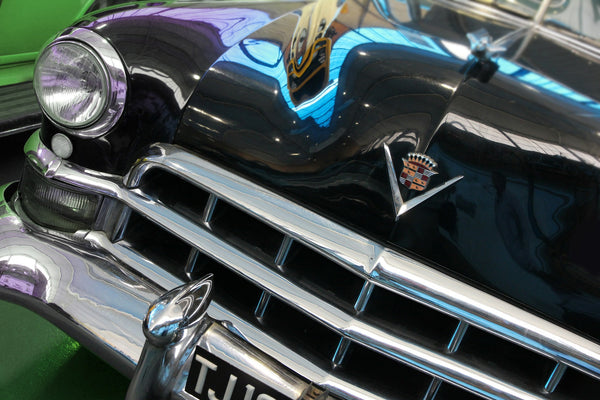
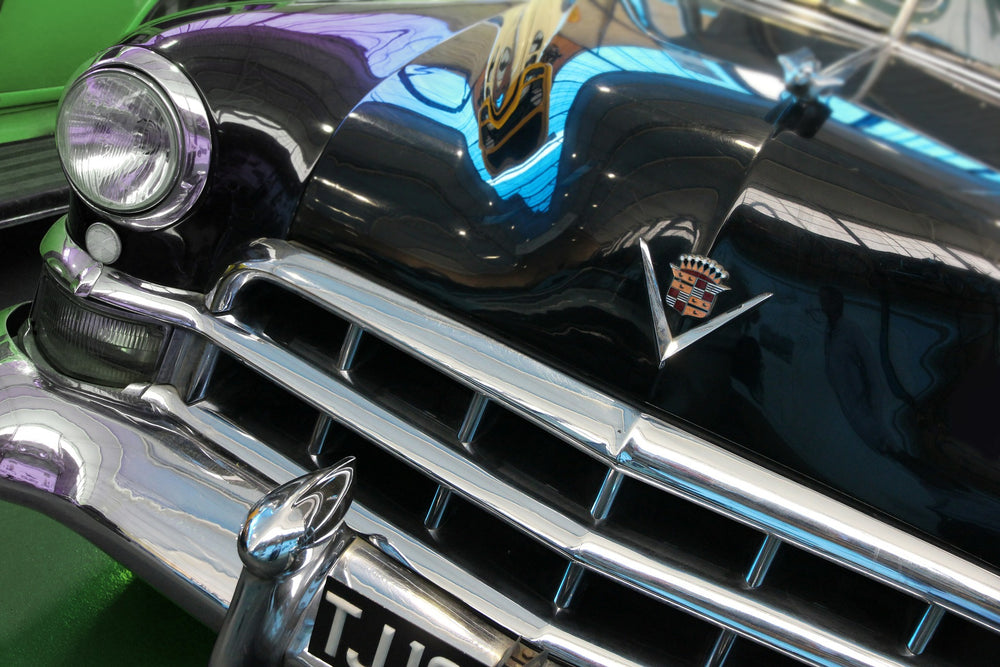
Waiting for the Black Cadillac, Redux
Who knows what’s behind our taste? A record that I think persists in its genius (My Life In the Bush of Ghosts) you may find abstract and boring. And that’s true even when it’s one that I worked on.
Over the years, I’ve got my favorite people I’ve worked with, and for a variety of reasons; some on the road, and some in the studio. I wish I had recorded with Bernie Leadon, but I met him when his solo record was finished – I toured with him off and on for about six months. There’s a guy who’s so on it that when I told him the songs that made me want to play were one-chord songs, he took it as a challenge, and immediately wrote a one-chord song; a really good one-chord song.
I have a lot of respect and affection for Jon Hassell. When we did City I was pretty intimately immersed in his career; I know a lot about the challenges he faces, and his persistence is impressive. I’m not sure I’m born to this, but Jon is. And I have fond memories of touring with Stan Ridgway (mostly in Europe). We came to a less-than-happy ending owing to his record company – Miles Copeland’s IRS Records – being incredibly cheap, but that was 30 years ago. We’re happy to see each other every now and then.
All this is a lead-in to writing about my number one choice of the records I’ve worked on. I’ve written a bit about the title track before, but it merits a more detailed look. Up to now, I’ve written about one or two songs from records I’ve worked on. But with Rosanne Cash’s Black Cadillac, I like it all.
At first, all I knew was that we were booked to do an album. For a very brief period, Andy Slater and Julian Raymond of Capitol Records considered Bill Bottrell, Brian MacLeod and myself their “A-Team”; their go-to guys. We moved into a (Neve 8078-equipped) studio in the Cahuenga Pass called Larrabee East[1] for 6 months or more, and worked with a variety of artists in that period, most of whom you probably haven’t heard of, however talented they were. They came along too late in Capitol’s long history to make a dent in a dying industry. Some were just expensive experiments: Bill and I worked with Dhani Harrison during that time – he later introduced me to his band-mates as the original bassist in his band, the New No. 2.
We brought a somewhat large collection of gear with us – Brian brought three drum kits, including a 1940s all-wood kit he called “The Blond Bomber.” Bill had half a dozen guitars. I brought 25 basses, a variety of racks of gear, along with a couple of old tubed amps (a Versatone and a Guild ThunderBass, both about 40 years old at the time) and tubed mic preamps to use as DIs (Telefunken/Siemens V-72 and EAR 824M)[2].
These have the virtues of distinctively different sounds – the Versatone, a “combo” amp with one 12-inch speaker, isn’t a very bottom-heavy sound, and is capable of the most god-head distortion ever[3]. But turned up to just below half way, it’s clean with a little bit of “hair” on it, a barely discernible amount of distortion, but when you play harder it breaks up nicely[4]. And the V-72, at least as it was modified for my use, does a very similar thing.
The other pairing was the Guild (with a separate cabinet and single JBL D140 15-inch speaker) and Tim DeParavicini’s EAR 824M, the insanely wide-band and uber-clean tubed mic amp. The 824M was also set up to do DI duty along with Tim’s Wedge-It input device. Though an absurdly expensive DI by anybody’s standard (somewhere north of $11,000), in combination with the Guild amp the resulting sound was full, warm, and pretty clean.
So for the run of the four or five albums we worked on, I had my set-up, and would swing a Neumann U-47 FET mic between the amps. However important all of this is to anybody else – not saying it is, or it isn’t – it was the culmination of my pursuit of a sound to go with what my hands were doing. With the old Ultrasone 650 headphones, the whole thing comprised a feedback loop, so to speak, and was as important to what I did then every bit as much as the sound that I developed for City was for my playing at the end of the 80s.
There’s one other thing I want to say in this introduction to Black Cadillac that might aid in understanding the necessity of all this. I’ve written before about meeting Rick Turner [formerly of Alembic, now of Rick Turner Guitars – Ed.], and learning about really good sound at a pretty early age. In some online conversation or other, Rick said of me that I could pick up a different instrument and find a different musician inside. This was a real surprise to me when he wrote it, but as I thought about it, I realized it was completely true. I don’t approach music one way; I approach it sonically and musically. Maybe it’s a sense of a musical gestalt. I think most people, if they had my particular madness, would do the same. I just pursued it to a logical end.
Next time, I’ll go into the making of Black Cadillac.
[1] The studio was built by Tom Jones in the 1970s, bought by the Andorra folks in the 90s, by the Larrabee people just before we worked in there – temporarily the third in their empire – and finally by Dave and Jaimie Way and their silent partner Brent Spiner, before going private.
[2] Direct-inject, a technique for recording an instrument without a microphone.
[3] Think Jack Casady on “Sunrise” from Paul Kantner’s Blows Against the Empire.
[4] Casady on the first Hot Tuna album.
Tracy Chapman, Redux
Some pop stars wear the glamour of fame and fortune, like a suit they’ve longed to try on since they first picked up a guitar or a mic. Keeping the garb of stardom on their backs becomes their primary musical goal. And then there’s Tracy Chapman. She hit the big time on a fluke, and doesn’t seem to care that the industry tired of her when she wouldn’t be exactly what they wanted.
When executives at Elektra heard a demo of her acoustic song “Talkin’ ʼbout a Revolution” in 1987 – the demo had been sent around by an enthusiastic friend, since Chapman was too busy writing and singing to think about promoting a career – they smelled a sweet revolution latent in a market oversaturated with synthesizers and hair metal. Chapman’s first album, the simply produced Tracy Chapman, came out in 1988; it was a massive critical and popular success, raking in three Grammys.
Besides several hit singles, that record also includes the exquisite “If Not Now,” which provides a fine introduction to the fatalism and longing in Chapman’s poetry, as well as her plaintive vocal writing. The short lines with breaths between them, and ornaments decorating them, make the powerful lyrics clearer.
Chapman had been reluctant to sign with a major company because she feared losing her original voice. The 1989 album Crossroads shows that she wasn’t kidding. She stuck to her guns and co-produced the album (with David Kershenbaum, who also produced the first album). It didn’t sell nearly as well as the debut. But Chapman stayed true to herself.
“Subcity” demonstrates her abilities as both storyteller and social commentator. Her use of language is so efficient that in only a few of her signature short phrases she’s built a three-dimensional world for her disenfranchised characters: “People live every day / On the waste and decay / Of the discards of their fellow man.”
It’s worth noting, that by this second album there’s more of a rock feel – in this case, a country rock swing – with drum kit and electric bass, although the acoustic guitar is kept to the forefront in the mix.
For her third album, Matters of the Heart (1992), Chapman collaborated with a new producer, Jimmy Iovine, who had already worked with Lennon, Springsteen, and Meat Loaf, and would go on to found Interscope Records and co-found Beats Electronics. So, this was never going to be a simple folk record.
The moving “I Used to Be a Sailor” swells with strings and a soft-rock drum beat. I can imagine Chapman singing this in a coffee shop with just her acoustic six-string, but that folk kernel has been swathed in thick layers of musical fabric. The more I listen, the more I doubt the fancy arrangement adds anything important.
Although Elektra kept Chapman on its roster until 2008, she only produced one more hit single, “Give Me One Reason,” from the 1995 record New Beginning. That very successful album, produced by Chapman and John Mellencamp collaborator Don Gehman, The production values are more subtle here than on Matters of the Heart, although there are dozens of musicians involved.
The easy-going arrangement of “I’m Ready” is a good example of this light hand in the production booth. Even the team of violins, backing vocals, steel guitar, and bongos doesn’t overwhelm the song.
If you search out the original recording, keep listening after “I’m Ready” ends for a hidden track called “Save a Place for Me.”
It would be five years before Chapman released another album. When she did return to CD racks, the public wasn’t buying. Telling Stories (2000) sold only one tenth the volume of New Beginning in the U.S.
As a whole, the album does not have a lot new to say musically. An exception is “Paper and Ink,” which is distinguished by its use of mandolin and dulcimer, adding an earthy Appalachian touch to Chapman’s warning about the destructive forces of greed.
Although Let It Rain (2002) was the first Tracy Chapman album not to reach the American charts at all, there’s a calm confidence in her singing that seems to demonstrate an artistic self-awareness and maturity. This is a songwriter who doesn’t give a fig how many records she sells.
The arrangements (co-produced by Chapman and John Parish) contribute to the atmosphere of inner peace, opening with a pedal steel so creamy it could pass for a synth on the title track:
A highlight of 2005’s Where You Live is “3,000 Miles.” There’s a painful irony in the contrast between the lyrics – recounting the shaming and abuse of girls, perhaps autobiographical – and the lacy, percussive music, as delicate as raindrops on a spider’s web.
The 2008 album Our Bright Future was the last project for Elektra, who (Chapman claims) got tired of her not making money for them. Although she toured in support of Our Bright Future in Europe, her U.S. tour was canceled. She hasn’t toured since.
“The First Person on Earth” shows her exploring instrumental sound effects – after all, what did she have to lose? Maybe the distorted wailing harmonics represent a primordial backdrop for this strange but touching love song. It’s a bizarre contrast against the strident rhythm of the melody, which is followed tightly by a snare drum all the way through.
In the slew of interviews Chapman did to promote her Greatest Hits album in 2015, she gives the impression that she would be perfectly contented to be out of the spotlight for the rest of her life. She has described the split with Elektra as setting her on the path to artistic freedom. In fact, she has not created another studio album since parting ways with Elektra – not even a self-produced effort in this era when every kid with an iPhone tries that.
But I doubt her public silence means she’s not writing songs. More likely, she’s once again the young college student who only wanted to stand up for social justice and explore her poetic musical voice back in 1987. We’re just not invited into the garden where she plays her guitar.
Interpreting Purcell, Redux
Henry Purcell (1659-1695) lived at an expansive time in British music history, when artistic freedom had been restored after a generation of repressive Puritan control. Somehow this allowed Purcell to tap into timeless universals of human existence. Not only is his music still performed often, but it gets reconceived for new eras more than most composers’ work does.
On the CD Purcell : Britten – Purcell Songs Realised by Britten (Champs Hill Records), six singers perform Benjamin Britten’s arrangements of one of his favorite composers – and this was a man deeply versed in the previous centuries of his nation’s music. The key to modernization here is in the piano part, which Britten originally wrote for himself to play while his companion Peter Pears sang. You can hear late Romanticism edging into modern harmonies, and the kind of rolling rhythmic textures that simply didn’t exist in accompaniment the 17th century.
“If Music Be the Food of Love,” sung by mezzo-soprano Anna Grevelius, seems to star pianist Joseph Middleton, but that’s typical of Britten’s approach to piano-and-voice writing; you find it in his arrangements of British and French folksongs, too.
Contrast that with this exquisite recording (from a 2001 Erato release) of the original Purcell by soprano Nancy Argenta, harpsichordist Paul Nicholson, and viola da gambist Richard Boothby playing standard middle-Baroque continuo:
Pulitzer Prize-winning composer Elliot Carter also paid homage to Purcell. On the Onyx Brass’ recent album Pavans, Fantasias, Variations (Meridian Records), there is a nuanced performance of Carter’s A Fantasy about Purcell’s “Fantasy upon One Note” from 1974. As the composer once explained, “The Purcell piece has always seemed to have a dramatic meaning—that of a repeated, tolling, bell-like note sounding through musical episodes of contrasting character. So I decided to make an arrangement for brass that would draw attention to this aspect of the music.”
When comparing with the original, played here on viols by Jordi Savall’s Hespérion XX, it’s striking how delicately played brass can be a reasonable substitute for bowed strings:
Like violins, violas, and cellos, the viol family comes in all sizes, and Purcell wrote what we would call “chamber music” for them (that term is an anachronism, only coming into currency in the late 18th century). Not surprisingly, viol music is often attempted on modern violins, etc. Two string quartets have recent recordings of Purcell Fantasias (or Fantazias, as he spelled it).
I admit to having a hard time with this concept. Unlike the change from viols to brass, the replacement of viols with the violin family always sounds wrong to me; maybe it’s because the instruments are close enough in sound that their differences stand out more. Contrary to popular belief, the viol is not a predecessor to or truly related to the violin: they have fretted and unfretted fingerboards, respectively, which affects the very concepts of fingering and intonation.
That said, the Emerson String Quartet gives a strong, musical performance on their new Music of Britten and Purcell (DeccaGold). Here’s the Fantazia No. 11 in G Major:
The recent recording of some of Purcell’s fantasias by the Apple Hill String Quartet (self-produced) does not fare as well. The overall sound is breathier, with more vibrato. The instinct is to say it’s “less authentic.” But then, once you switch to instruments that did not exist in the composer’s lifetime, who’s to say what “authentic” means? Still, I longed for first violinist Elise Kruder to make more stable contact with the string, no matter what she was playing.
The biggest sonic difference between viols and the modern violin family is the more subdued timbre in the former. Compare those Emerson and Apple Hill tracks with this recording of Purcell’s Fantazia No. 8 in D minor as played by the group Wildcat Viols, a teaser from their album-in-production, The Magnifick Four:
Presenting Purcell in modern ways is not a new idea, and the range of creativity in evidence is astonishing. Here’s a classic example: Wendy Carlos was asked by Stanley Kubrick to arrange some Purcell on the Moog synthesizer for Kubrick’s 1971 film of A Clockwork Orange. Carlos turned Funeral March for Queen Mary into one of the most frightening pieces of music ever:
The potential is limitless; Purcell works well in any guise. Once, in a Manhattan subway station, I heard a woman playing “Dido’s Lament” on a saw. After I recovered from my surprise, I found it beautiful.
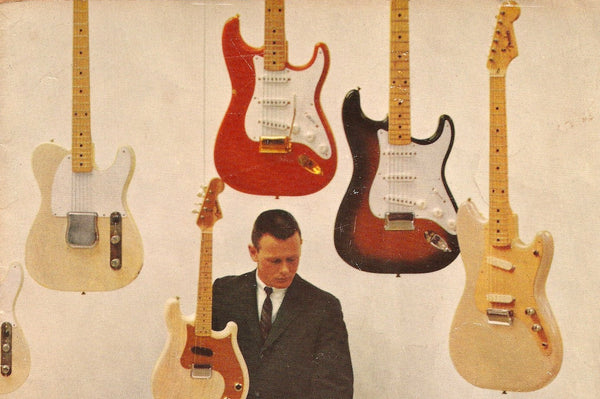
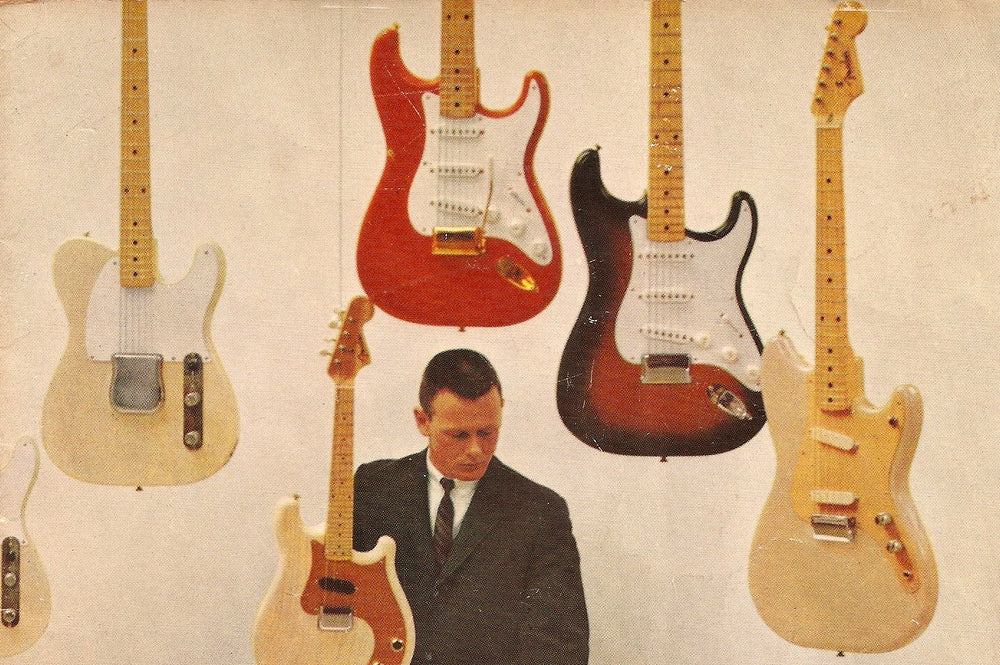
Ears in the Clouds

As anyone who's heard one knows, they weren't kidding. From Audio, December 1960.
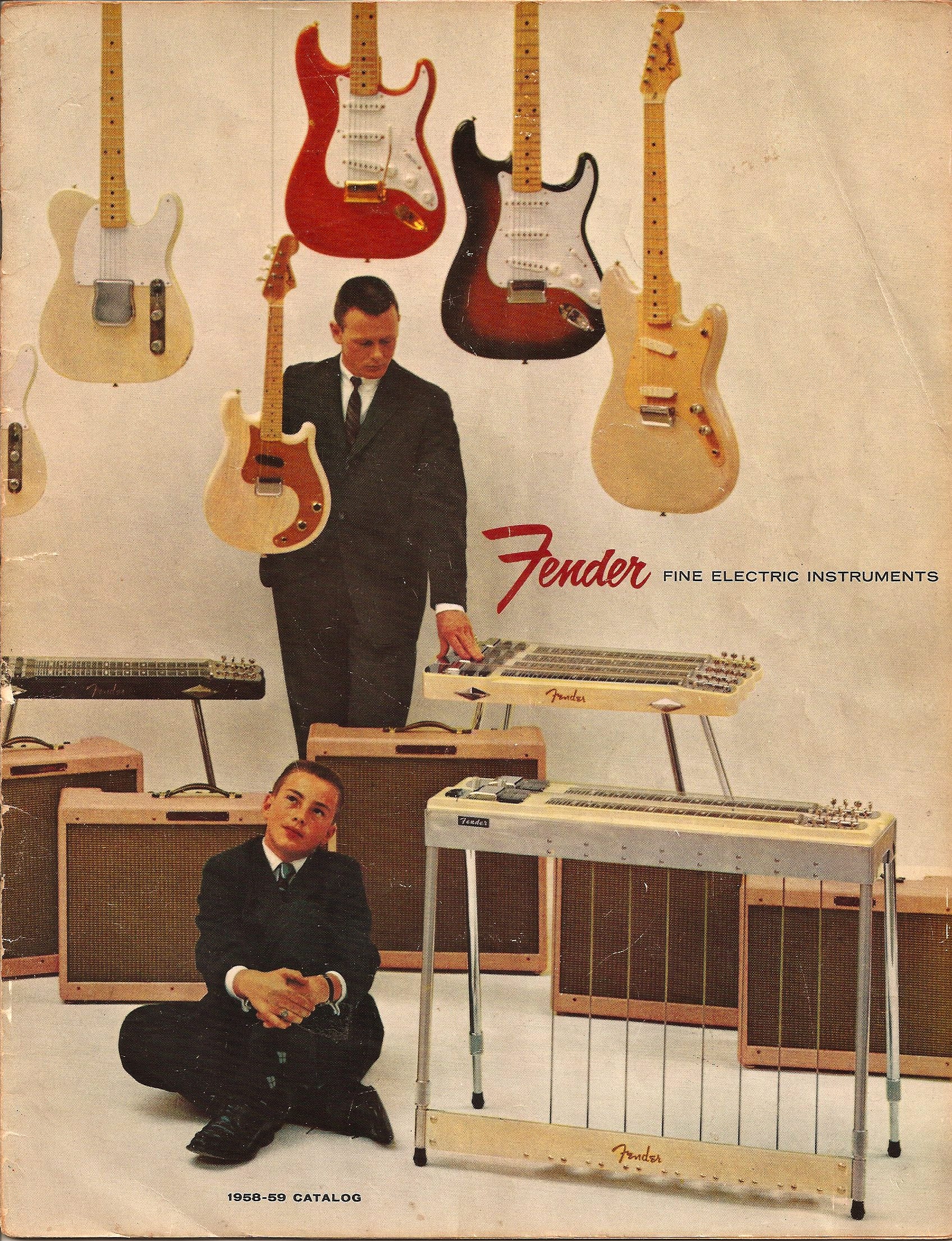
Maybe not strictly audio-related, but what a stunning cover, and we've sure heard plenty of this gear on record. 1958-1959 Fender catalog, author's collection.

Guess their female readership wasn't high. From Audio, February 1959.

"For the home music fan, this pair of aces guarantees a house full of audio pleasure." If not a winning hand...
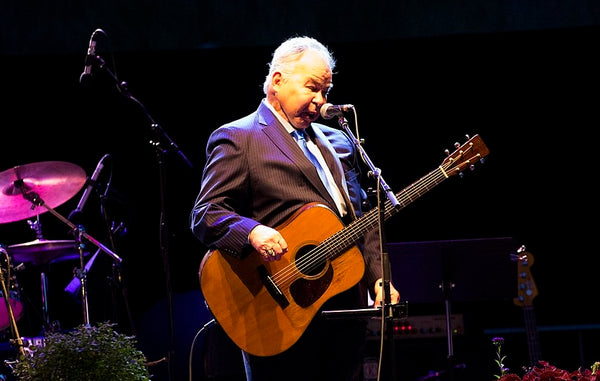

John Prine – In Spite of Himself
I did a Copper piece on John Prine a year ago (Issue 80). However his passing on April 7 brought me back to the closet. John was a friend to all Americans and a music mentor to me for 45 years. I will miss him as will his legions of fans.
Our generation’s Mark Twain was born in a Chicago subdivision called Maywood just north of the Eisenhower Expressway. Mom and dad came from Muhlenberg County in Kentucky. Every summer the family would travel back to Paradise, Kentucky to visit family.
At this point John had been singing that song for about ten years and it still made him smile. I’ve been listening to it for 45 years and it does the same for me.
John Prine grew up in Chicago and when he was 14 his brother taught him to play guitar. Brother David turned young John onto a Ramblin’ Jack Elliot record and the journey was started. Boy howdy, Ramblin’ Jack Elliott. There’s another story right there.
In the beginning Prine never considered a career in music. He worked a mail route. Sure, he played at parties with friends but never believed he could make a living at it. In January 1966 he and his friends were drafted. Some went to Vietnam, some stayed stateside, and John ended up in a motor pool in Germany.
Upon returning to the USA in 1968 John experienced that beside the tragedy of 58,000 American troops killed (according to a National Archives estimate), among those who did return, many never really made it back. Prine went back to his mailman job in 1968 and started writing songs in his head while on his route. “Sam Stone,” one of his greatest and most well-known, was written in this way and he said the song came from his trying to reconcile what had happened to his buddies. He hurried home after work to pick up his guitar and make sure the song sounded as good as it did in his head. Um, it did.
One night Prine was drinking beer at a Chicago pub called The Fifth Peg, which was holding an amateur night. By his account the talent was “pretty awful” and at one point he said that aloud. Someone at the bar turned and said, “you think you can do better?”
John got up and sang “Sam Stone.” He later related in an interview that at the end of the song the bar was dead silent and he thought, “Uh oh. That was a short career.” Then the joint erupted, of course. He went on to sing the other two songs he knew, “Hello In There” and “Paradise.” Management hired him for a weekly gig so he had to go home and write more songs for the next week.
So dig. The first three songs he wrote were “Sam Stone,” “Hello In There” and “Paradise.” Shiver me timbers.
While Prine was playing at The Fifth Peg, Steve Goodman, another young and balding songwriter, stopped in. This started a fortuitous and deep friendship that lasted until Goodman’s untimely death in 1984.
In 1971 Prine was playing at the Earl of Old Town and Steve Goodman was performing at another club in Chicago with Kris Kristofferson. Kristofferson was talking to Goodman about getting Steve into the studio and good man Goodman insisted they go over to catch Prine’s set at the Earl. They showed up along with Paul Anka and Samantha Eggar. Kristofferson was so impressed he told Prine, “you keep writing songs this good we’re gonna have to break your thumbs.” Instead he hired Goodman and Prine to come to New York and open for him at the Bitter End. In the audience was Jerry Wexler from Atlantic Records. The next day Wexler signed Prine and Goodman to contracts. Yeah. That’s how that happens.
There’s a great story of Prine and Goodman celebrating (drinking) in a hotel room at the Waldorf and writing “You Never Even Called Me By My Name.” This is one of my favorite Goodman tunes. Steve showed the song to David Allen Coe as the “perfect country song” and Coe expressed it was missing key elements like dogs, trains, drunks, pickup trucks, prisons and mothers. Goodman added a last verse and Coe had a hit.
This live version has a slightly different last verse than the one Goodman recorded. The studio version did mention a drunken dog.
By the way. Steve Goodman was a hoot. Wrote “City of New Orleans.”
John Prine did play at Red Rocks in 2019. But not in July as first advertised. He had to have surgery and postponed the tour.
Prine was a life-long smoker and in 1999 had surgery to remove squamous cell cancer from his neck. In 2013 he again had to go under the knife to remove cancer in a lung. The result changed his voice and almost ended his career. He related in an interview that during rehab his doctor said he wouldn’t release him to tour until he could run up and down stairs then sing while still out of breath. John pulled it off and in 2014 was touring again.
But the health problems caught up with him. He had to postpone our July 2019 Red Rocks concert from July to September. My wife Diana and I had been huge fans ever since a band I played with in the 1970s did a lot of his music. We were really looking forward to the show. In fact this was my 65th birthday present.
Diana had to have surgery herself in August and so could not attend the concert in September. I took my daughter Amanda who grew up around his music and we had a wonderful evening in the magical Red Rocks Amphitheater in Morrison, CO. I cried the entire night. There was one tissue in my pocket and I abused that little guy. I guess I was overwhelmed by the combination of knowing all the songs and that likely I would never see him again. Plus Diana missed it, and I missed having her there as well.
A couple of days later I was cooking Sunday breakfast and we had John Prine streaming from the living room. I started tearing up during “Who’s Gonna Take the Garbage Out” (when I’ve packed my bags and gone.) Yep. Pathetic.
Prine continued that tour but in New Zealand had to stop because of leg problems. By April we’d heard he’d been hospitalized with the COVID-19 asshole virus and he didn’t make it. He passed from us on April 7 at the age of 73.
Like the song says, John’s wife Fiona spread some ashes into the Green River. The rest were buried next to his parents in Chicago.
I read they sent his stomach to Milwaukee in case they ran out of beer. They put his sox in a cedar box and got them out of there. Venus de Milo got his arms, someone else got his nose. They sold his heart to the junk man, and gave his love to Fiona.
Bonus. Early Prine talking about his grandpa and grandma.
Bonus 2. Yeah, he’s worth it. In 2001 Prine had a supporting role in a Billy Bob Thornton movie called Daddy and Them. Thornton loved Prine’s music and asked him to write a song for the movie. Here is John with the honey-tongued Iris Dement, In Spite of Ourselves. There’s a reference to Oh Boy Records. He formed the company in 1981 so he wouldn’t have to deal with the main labels. Prine said in an interview he named the label because in good times you’d say “Oh Boy!” and the same in bad, minus the exclamation point.
No one will miss John more than Fiona, Jack, Tommy and Jody. But coming in hard are the lucky folks who cherished his music and unique style of storytelling while we shared sky, highways, farms and rivers. God bless you John. Kiss that pretty girl on the Tilt-A-Whirl for us.
Header image courtesy of Wikimedia Commons/Yellowstone National Park/YPF/Matt Ludin.
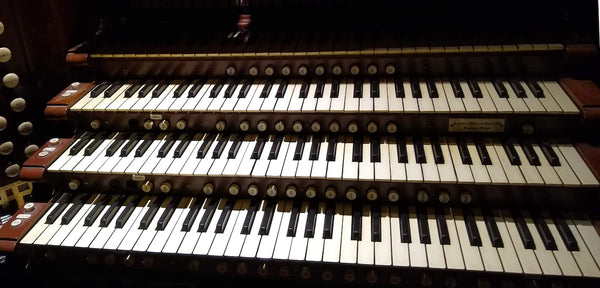
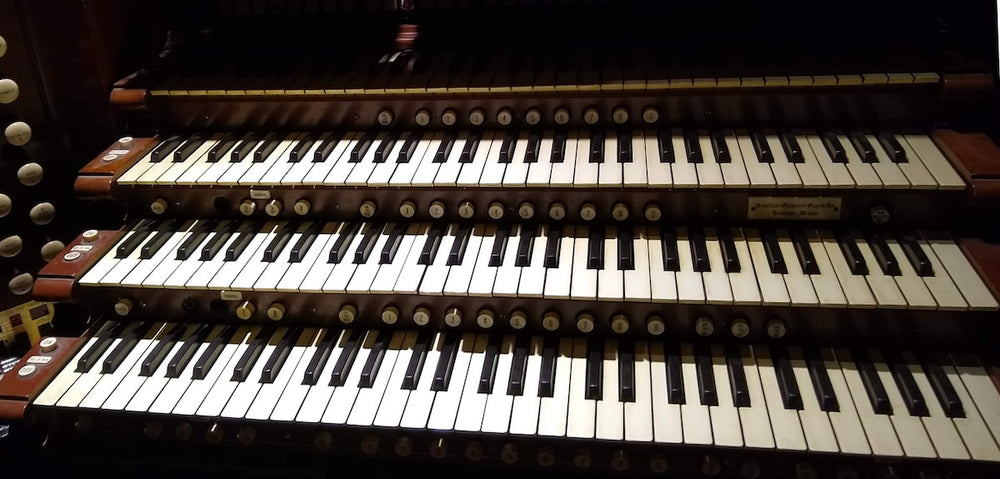
Breathing Restored Life Into a Classic Pipe Organ, Round Two
 Kamel Boutros.
Kamel Boutros.- Latency of varying milliseconds across all four of the keyboard manuals, making any kind of staccato playing virtually impossible;
- Temperature sensitivity of the metal pipes within the 200-year-old stone and wood church. The pipes can vary individually from A440 standard concert pitch anywhere from A427 to A442.
- Access to stops that were inoperable to blend with the ones that were still in use.
 Hauptwerk controls.
Hauptwerk controls. Where it all comes together.
Where it all comes together. Some of the original pipes.
Some of the original pipes. The Yamaha concert grand piano.
The Yamaha concert grand piano. The Behringer X-32 front of house mixing console.
The Behringer X-32 front of house mixing console.
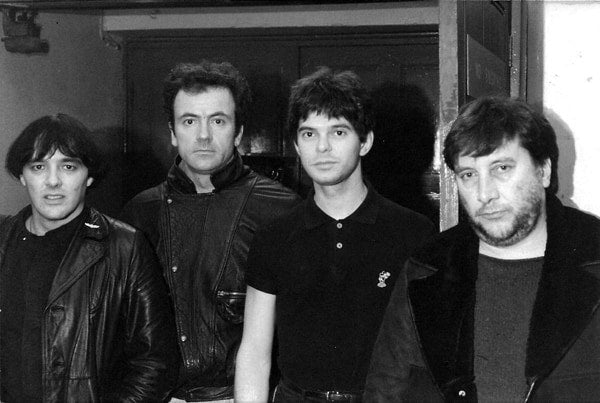
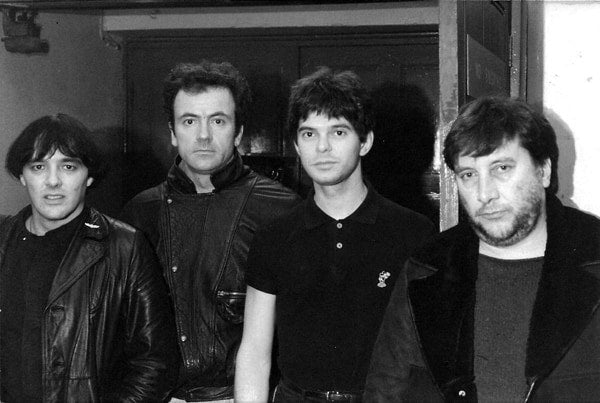
Pond Hopping with the Stranglers
The heat is coming on and the pipes are clanking. It is a comforting sound. Across the street is Carnegie Hall. You can see the entrance by looking through the dirty windows. Because it is winter there is no sunshine, only shadows in the canyons of West 57th Street. To add to the grimness there is the noise of crosstown traffic.
February 1981. The meeting is with Ed Kleinman in his small office that is Fast Forward management. The job, tour manager of the Stranglers for their UK tour supporting the album The Gospel According to the Meninblack. The Stranglers are one of the more successful British punk rock/new wave bands of the era and had already had success with singles like “Something Better Change” and “No More Heroes.” (After this tour they would score major hits with “Golden Brown,” “Always the Sun” and others.)
 The Gospel According to the Meninblack album cover.
The Gospel According to the Meninblack album cover.The tour is booked and advance ticket sales are robust. The pay and per diem are good, and Ed seems all right. Besides, I thought, this has the potential for an interesting experience. What could go wrong?
I accepted the job, and, in a few weeks’ time I was at JFK boarding Pan Am’s evening Flight 100 to Heathrow airport (LHR). The flight landed in the UK just after sunrise and returned to JFK that same afternoon. The British affectionately called the flight “The Pond Hopper.” The New York-London rotation, Flights 100/101.
This was back when flying was fun. it was the best Pan American has to offer in terms of the aircraft and the service. Because of this the giants of industry, government and entertainment were regular customers. (The Beatles took Flight 101 on their first trip to the States in February 1964.)
It is March in the UK and the weather is cold, damp, and mostly cloudy. That is their normal weather for most of the year. In New York City we get that weather sometimes, but England owns the patent on this climate. It is the time of Margaret and Ronald and the “Troubles” in Northern Ireland. This is before the Falklands War.
We are currently on tour in England and we’re up North. It’s our day off. Some of the group and road crew are hanging in one of the hotel rooms. Nice hotel, big rooms. We have plenty to party with.

Me? I am the only “Septic,” or as it’s said, “Septic Tank.” That is Cockney rhyming slang (Yank = Septic Tank). The rest of the band and crew are from London and the West Country. It is not often that we all get the same day off and are staying at the same hotel. It is nice to just hang with the lads.
I had just hired a new lorry (truck) driver. Our regular driver had become unreliable because he got strung out on Harry, so I had to sack him. That is the thing in rock and roll. You can do whatever drug or drink you would like, as much as you want and whenever you want and most people in the business will look the other way, but the tour and your job come first. If you don’t show up, on time, with your sh*t together, then you are gone.
So, this new guy, Ian, had just separated from the British Army and he was glad to be out. He was stationed in Belfast and in his words it was “disturbing duty” and involved harassing young Irish men. Ian became disillusioned and left. Now he was our driver.
Ian and I have an understanding. We are both military veterans who became disillusioned with our mission. That is why I hired him and now he loves this rock and roll lifestyle. Plus, he has that Army can-do mentality. He gets the job done.
At present we have a road crew of eight and the Stranglers are four, add myself and that makes thirteen. The merchandising group is run by Stranglers’ founder Jet Black’s brother and they travel separately, but I collect their cash along with the box office receipts each night. Sometimes I’m carrying in excess of ten thousand pounds, in which case I bank transfer those monies to band’s bank account in London. That seems to work out to three mornings a week, more or less.
My job of tour manager is much like a crisis manager. I move the business almost daily, two separate entities, the band and their equipment and crew (they’re on different schedules. I hire and fire, collect the monies, sometimes in percentages such as 80/20 (80 percent for the band), but usually, it is a guarantee against a percentage {whichever is greater}. I pay salaries, petrol, and hotels. Schedule all travel. Then do all the accounting (expenses and all cash income). I run every aspect of the company on the road. There is a lot that can go wrong, and things do, but you keep the show going. A bad decision can cost serious money, not to mention the reputation of the band or me. The job pays well and is exciting, engaging, and personally rewarding, not to mention there are some way cool perks. If one is not up to it, it becomes apparent quite soon.

I am acutely aware that carrying a briefcase full of cash makes me a target and that is where Ian and Russell (Ian’s assistant) come in. Being truck drivers means that during the show itself their truck will be parked. Thusly freeing up the boys to do what I call casual security. The British concert scene was much more prone to dust-ups than its American counterpart. My boys, just like me, had all-access backstage passes and could roam the concert hall at will. Their job was first, to keep an eye on me, second the band and crew and finally our equipment.
I need to move around fast and not with an entourage, so they watch over me from a distance. In fact, no one would associate them as being my minders. That is till trouble begins, and then they descend like birds of prey, instantly. Mostly this protocol was unnecessary, but one night in Manchester they more than earned their worth.
Three skinheads jumped me coming out of the promoter’s box office. “You! Septic tank,” the middle one growled at me while grabbing the front of my shirt. He pulled me to him, and head-butted me right in my forehead. Blindsided and suckered I stumbled back on rubbery legs. As I fell into the wall the one on my left punched me right in my jaw and I saw stars, a big white flash and I went down landing hard on my left shoulder. The third one grabbed my briefcase, ripping it from my hand.
He turned to run and was one step away before he was cross-blocked into the wall by Ian. His mates were just behind him when Russell grabbed the slowest one by his arm and spun him around headfirst into the wall. The one left standing was stupefied and backed up a step. Ian grabbed my case from the skinhead on the floor. Russell pushed the one left standing and he staggered backwards down the hallway. Ian grabbed me by my upper arm and helped me up while Russell gave the skinhead on the ground a vicious kick, knocking out a couple of teeth. The skinheads had enough of the fight and scrambled away.
My face hurt and I had the beginning of a big welt on my jaw. “I need some ice,” I said to the boys – and they laughed. “Ken, man, this is England, even the beer is warm! No ice here, mate!” We all cracked up laughing. All in a day’s work.
Next day, we had a gig in Newcastle, (the home of Newcastle Brown Ale). There, drinkers call it “Newkie Brown.” The week before, the Stranglers’ management office had received a letter saying that one of the band’s devoted fans had been paralyzed from the waist down in a motorcycle accident and would never walk again. In the letter the fan’s brother asked, “could the band please visit him in hospital?” Management forwarded the letter to me and I showed it to the band. They agreed.
Unannounced, we walked into his hospital room, and the guy could not believe it. It was a special moment. He broke down in tears, sobbing really. His life was over, he said, as he would never walk again. Jet then pointed out to him that if he did not matter, then the band would not have come. Of course he was important, and this was not the end for him, but a new chapter.
The guy’s load seemed to lift and after thirty minutes or so the band said goodbye and this guy had an ear to ear grin, with his spirits by now much improved. This was a “secret mission,” so please, no press coverage on this, J.J. (Jean-Jacques Burnel, the bass player) and Jet Black (the drummer) told me as we left even though it would have cast the band in a flattering light.
Next day we drive south to Nottingham. Normally we play the Apollo and Odeon theater chains. These are mid-sized (3,000 capacity or so) concert halls sprinkled around the UK, but today we were playing a big club for about two and a half thousand people.
That night, backstage I gather the band up and get them up on stage. I head back toward the dressing room and I spy this good-looking lassie smiling at me. Her eyes are sparkling. “I’m Debbie,” she says; “can we talk privately?” “Sure, come into the dressing room.”
I close the dressing room door and she steps up close to me. In less than five minutes she is done with me. I have business to attend to, so I head over to the box office to pick up tonight’s gig money. After counting out the band’s fee I then walk over to merchandising to collect their nights’ proceeds and pick up a silver raven pin (see picture) for Debbie.

After the gig, I load the remaining booze and beer from the dressing room in the boot of our rental car. I grab a couple of band members along with Debbie and we drive back to our hotel.
Next morning after breakfast, I load up both our cars with the band members and head south. Tomorrow night, it is the Hammersmith Odeon, London, sold out.
Rock and roll life has its moments.
The Stranglers band image courtesy of Wikimedia Commons/Stranglers France Service.

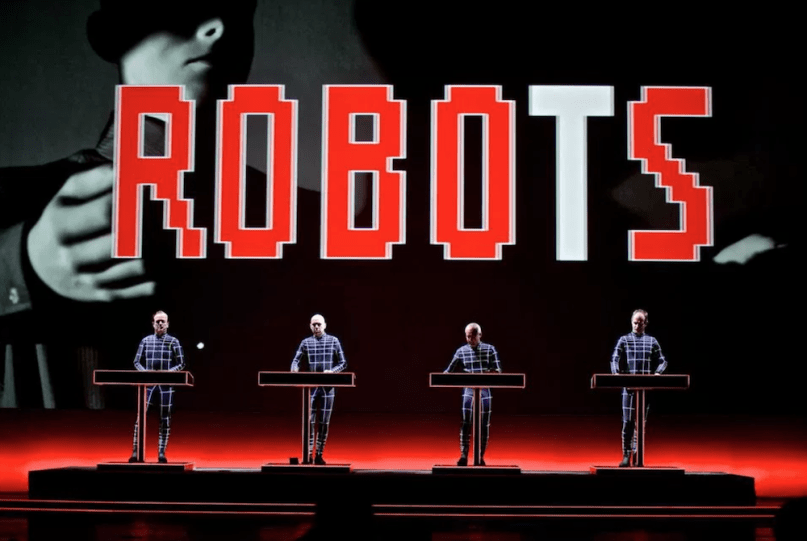
The Incalculable Influence of Kraftwerk
Kraftwerk’s influence on today’s pop music is so pervasive, the band is so historically important, and so much has been written about them already that doing an introduction here almost seems clichéd. But for those who haven’t been plugged in: they more or less invented electronic pop music.
As such, they’ve had an incalculable influence on contemporary pop, with their pioneering use of synthesizers, hypnotic metronomic electronic beats, vocoders (those “robot” vocals of which Auto-Tune might be considered a direct descendant), repetition, sampling, minimalism and electronic sound processing. Not to mention their retro-futuristic visual aesthetic and unified gesamtkunstwerk (“total artwork”) presentation. The sound quality of their albums is uniformly stunning. No other electronic band is as elegant as Kraftwerk.
Every, and I mean every techno, house, dance, club music etc. artist owes their existence to Kraftwerk as do bands like New Order, Depeche Mode, Orchestral Manoeuvres in the Dark, Daft Punk and countless others – a fact most of them have readily admitted. Two Kraftwerk songs alone, “Numbers” and “Trans Europe Express,” set the rhythmic template for much of hip-hop. (The 1982 hip-hop smash “Planet Rock” by Afrika Bambaataa and the Soul Sonic Force stole from both, which was later resolved in a settlement.) Their all-electronic sound was radical, literally unheard of in the 1970s in an era when guitars and strutting rock stars dominated rock music.
I thought I’d make this look at Kraftwerk a little more on the personal side. And of course it’s tempered by the loss of founding member Florian Schneider on April 21, who as the band’s “sound fetishist” must at this point be considered one of the most influential pop musicians of all time.
The band is one of my favorites, but that wasn’t always the case. I first heard their unlikely hit “Autobahn” on the radio when it came out in 1974 and thought it was a pleasant-enough almost-novelty song. I remember hearing it in some store in the Smith Haven Mall.
In 1975 I read an interview by Lester Bangs in Creem where Kraftwerk founding (and sole original) member Ralf Hütter said he thought Blue Öyster Cult was “funny.” What? How dare him! At the time I revered BÖC in the way only an adolescent rock-star-worshipping male can. (Of course, Hütter was, in a large respect, right, both bands having a distinct tongue-in-cheek aspect to their respective oeuvres.)
Kraftwerk wasn’t on my radar again until the late 1970s when I was at a Halloween party mostly attended by a bunch of computer nerds and their wives and significant others. I was in a bad mood…unemployed, wearing a crappy thrown-together costume, girlfriend-less…when some boring, repetitive music started playing on a crappy stereo. One of the nerds started going on and on about how great this band Kraftwerk was. “The music sounds simple, but it changes over time. Listen to how good those synthesizers sound.” (This on an AM-radio-quality stereo.) “It’s genius!” Already predisposed to dislike them, the album playing, The Man-Machine, didn’t do anything to convince me otherwise.
But…fast forward to 1981. A bunch of friends were driving to a show at the Left Bank, a New Wave club in Mount Vernon, New York. We were listening to WNEW-FM and all of a sudden this incredible electro-pop song came on the radio, filled with bloops and bleeps and otherworldly synth sounds, driven by an irresistible mechano-beat. As the song faded out I yelled out, “Quiet! I have to hear who this is!” The announcer stated, “That was the new single ‘Pocket Calculator’ by Kraftwerk.” Kraftwerk? That band I turned my nose up at? Wait a minute! I bought the single (a Japanese import 45) immediately thereafter.
Maybe a year later I was at a party. I had been…partying. Around 1 or 2 am I was ready to go to sleep and not about to drive home. A woman friend who lived in the house offered to let me crash on her bed with her. As I was lying there about to drift off in an altered state, she said, “let’s listen to some music to go to sleep to.” (Put your imaginations to rest – nothing untoward happened.) She put on Computer World, the album with “Pocket Calculator.” The first hypnotic synth sounds percolated out of the speakers. I was riveted. It sounded like something from an alien race from another galaxy. That night I finally, really “got” Kraftwerk. What are these sounds? What is this music?
I soon went on a quest to buy every Kraftwerk album in both English and German-language versions. The more I’ve listened, the more I’ve grown to like, then appreciate, then be continually amazed by this band.
Here’s a brief tour of their albums. (We’ll skip the early compilation albums Exceller 8 and Electro Kinetik.) I prefer the German-language versions; they sound more, well, Kraftwerkian to me.
Kraftwerk, Kraftwerk 2, Ralf and Florian (Ralf und Florian) (1970 – 1973)
These first three proto-Kraftwerk albums are considered “archaeology” by Hütter, and the first two, with their wandering jams and use of guitars, bass, acoustic drums and other conventional instruments bear little resemblance to the band’s future sound. In some parts and more so with Ralf and Florian, though, in tracks like “Kristallo” (“Crystals”) and “Tansmusik,” (“Dance Music”) we start to hear elements of the band’s later work – drum machines and heavier use of electronic keyboards, though pre-synthesizer. And the album contains one of their most beautiful if incongruous songs: “Ananas Symphonie” (“Pineapple Symphony”), featuring almost 14 minutes of…lap steel guitar.
Autobahn (1974)
The international pop smash breakthrough. The album-side-long title track is one of the most perfectly-realized pieces of program music ever conceived – it really does sound like a drive down the motorway with its loping beat, hypnotic “Wir fahren, fahren, fahren auf der Autobahn” vocal chant, Minimoog, ARP Odyssey and EMA Synthi AKS synthesizers mimicking the sounds of cars and trucks, and the use of repeating melodies and phrases, which would later become cemented as Kraftwerk hallmarks. This was the last Kraftwerk album to feature electric guitar, violin, flute and other “standard” instruments.
It’s also a sonic blockbuster, one of the first to appear on The Absolute Sound Super Disc list (and still there). On a good pressing or mastering, the bass is subterranean, the soundscape vast. There’s even a section where Kraftwerk tunes in the car radio to listen to themselves, and on a top-notch system, it sounds like you’re in a car listening to a car radio while driving with the sounds of the Autobahn surrounding you. The rest of Autobahn is also sublime.
Radio-Activity (Radio-Aktivität) (1975)
This album about radio waves and radioactivity might be the strangest-sounding of the lineup. It’s the first album to feature the “classic” lineup of Hütter, Schneider, Karl Bartos and Wolfgang Flür, the latter two on electronic percussion. There are only a few conventional “songs,” interspersed with odd blips, vocoded spoken intervals and other sonic weirdness. Oh, but those songs – “Radioactivity” is an ominous Vako Orchestron-driven warning about the potential dangers of nuclear power. “Airwaves” was the hit that wasn’t, maybe because of its simplistic lyrics, another future Kraftwerk hallmark. And the closer, “Ohm Sweet Ohm” is a gorgeous way to fade out the album.
Trans-Europe Express (Trans-Europa Express) (1977)
If Autobahn was a breakthrough, this was a landmark, chosen by many as Kraftwerk’s best. The influence of the title track cannot be overstated. The group took major strides in refining their sparse, yet multifaceted sonic and rhythmic approach (the title track was about a train, after all). The use of the sequencer appeared as a key propulsive and melodic instrument. This album, perhaps Kraftwerk’s “friendliest” and most accessible, has it all – sonic innovation and incredible sound quality, warm, inviting melodies (“Europe Endless,” “Showroom Dummies”), more than a touch of that sly humor (although “The Hall of Mirrors” is starkly foreboding), and it’s simultaneously nostalgic and light years ahead of its time.
The Man-Machine (Die Mensch-Maschine) (1978)
Perhaps no album has ever been so appropriately titled. This really does sound like an inevitable collaboration of man and machine. One enhances the other. Here, the band took another evolution into their hallmark mechanistic sound and to becoming even more firmly and unmistakably Kraftwerkian. The song titles: “The Robots,” “Spacelab,” “The Man-Machine” tell the tale, the latter putting the concept of “cybernetic” into perfectly-realized musical form. And the album yielded a bona-fide hit, “The Model,” maybe the closest Kraftwerk would come to conventional pop music. The sound is demonstration-quality rich, warm, extended, textured and compelling.
Computer World (Computerwelt) (1981)
39 years later, the album still sounds vastly ahead of its time. Where do I begin? If The Man-Machine was a major evolution, Computer World is a quantum sonic and musical leap of an almost incomprehensible nature – were it not for the fact that it’s right here for all to listen to. The sounds are otherworldly, fantastic in the literal sense, mind-blowing. The music and melodies span from regal (“Computer World”) to playful (“Pocket Calculator,” “Numbers”) to wistful (“Computer Love”) to almost too much for feeble human minds to comprehend (“Home Computer”). Their use of the sequencer as a rhythmically compelling element can only be described as remarkable.
While others pick Trans-Europe Express as Kraftwerk’s best, for me, Computer World is their towering masterwork. And the sound quality is out of this world, a vast, expansive soundscape from the ever-morphing bass to the alien-machine rhythmic clacks. Deceptively simple at first, but the more you listen, the more little sonic details you hear. And yes, the album is as predictive of today’s world as everyone says it is, right down to the idea of computer dating years before others could even frame the concept.
Electric Café (later renamed Techno Pop with revised track listing) (1986)
Perhaps Kraftwerk knew that after the astonishing advancement of Computer World the only other possible course was a musically minimalist detour. Much has been made of the fact that Ralf Hütter was involved in a serious cycling accident at the time, and the fact that the rest of the pop music world from the Human League to Heaven 17 to Donna Summer was catching up to them sonically. In any case, after Computer World, Electric Café was seen as a regression, and I was disappointed with it at first, having expected a continuation of the astonishing sounds of the former.
Yet in the ensuing decades I’ve come to embrace it and really dig it, especially the side-long opening suite of “Boing Boom Tschak,” “Techno Pop” and the now-classic “Musique Non-Stop.” (I could live without the “scrolling through the presets” parts of “Techno Pop,” but even Kraftwerk revised that down the road.) It draws you through an unhurried musical progression. The sound is more polished-metal, starker (the use of digital instruments like Yamaha FM-synthesis hardware, the LinnDrum, and the E-Mu Emulator II sampler contribute). And “Sex Object,” especially in its original German “Sex Objekt,” surely must have been tongue-in-cheek, an odd mix of aloof vocal delivery, sinister aura and Ralf’s “who, me?” vulnerability. Or maybe you’ll just think it’s silly. The re-issued Techno Pop offers a slightly revised track complement, with a remixed “The Telephone Call” and the added “House Phone.” The closing “Electric Café” gives us a few minutes of those Kraftwerkian bloops and bleeps and hints at what the rest of the album might have been had they gone that route – and where the band was headed.
The Mix (1991)
This remix album of previous Kraftwerk classics either feels unnecessary, considering the musical and sonic perfection of the previous albums, or prescient, considering that these retooled arrangements formed the basis for their live performances following. (I vote for the latter, seeing The Mix as a sort of alternate-reality Kraftwerk album.) Karl Bartos and Wolfgang Flür had left, to be replaced by Fritz Hilpert (still with the band today) and Fernando Abrantes. Not strictly a greatest hits album (“The Model” isn’t here), it features revamped versions of classic tracks like “The Robots,” “Trans-Europe Express,” “Computer Love,” an amped-up version of “Radioactivity,” and “Autobahn.” Like every Kraftwerk album, the audio quality is superb, with a myriad of new digitally-precise sounds, beats and musical ideas spread out on an expansive sound field.
Tour de France Soundtracks (2003, later retitled Tour de France)
After more than a decade of wondering whether Kraftwerk would ever release another album came Tour de France Soundtracks. Of course the expectation level could not have been higher. It was supposed to have coincided with the 100th anniversary of the bike race but did not make the date. And the album is a worthy addition to the canon, with the extended “Prologue” and “Tour de France Étape 1, 2 and 3” suite offering an irresistible mix of the new sounds I was hoping for on “Electric Café” and a rhythmic drive perhaps unequalled by any previous albums, and with Kraftwerk that’s saying something. There’s a remake of the title track, which for inexplicable reasons had never appeared on an album before, which I wouldn’t call better or worse, just different. “La Forme” is Kraftwerk at their most majestic, and “Chrono” and “Titanium” have that otherworldly sound that no other band will ever produce.
Minimum-Maximum (2005, available in English and German)
Finally, an official Kraftwerk live album, available in DVD video as well as audio formats. A double, so it’s fairly comprehensive with 22 tracks including most of the “hits.” As anyone who’s seen the band knows (I’ve been lucky enough to have seen them eight times including one of the legendary MoMA Kraftwerk-practically-in-your-living-room performances, courtesy of winning a Volkswagen contest), Kraftwerk is continually updating and tweaking their sounds, so these are fresh takes on the classics. Need I even mention that the sound quality is exceptional. Oddly, the surround sound is in DTS 5.1 only – I’m guessing that at the time, Dolby Digital wasn’t good enough for the sonic perfectionists from Düsseldorf.
If you want to add just one Kraftwerk album to your collection you would not go wrong with this. Also, Florian Schneider left the band after this album, making Minimum-Maximum the only release where you’ll get to see and hear him “live.”
The Catalogue (Der Katalog) (2009)
This limited-edition box set included the first “officially recognized” eight albums from Autobahn onward, remastered on CD. As Hütter noted a few years earlier, the original tapes needed digital transferring, remastering and restoration. They are presented here with album cover and other artwork that is mostly different from the originals; not surprisingly, more simplified and minimal. The sound quality is as good as CD gets and arguably improved in some cases, maybe not in others, although good original vinyl pressings are also superb. I’m not going to dwell on it here because this set has become out-of-print unobtanium (and mine’s not for sale) – at the moment there’s a copy on eBay and the seller’s asking $1,409.16!
3-D The Catalogue (3-D Der Katalog) (2017)
Another Kraftwerkian move – follow a live album with…another live album, 12 years later. But what a live album – it’s available in Blu-ray (video and audio), hi-res download and other formats, and the unabbreviated versions encompass full concert recordings of all eight previous studio albums from Autobahn onward. There’s even a surprisingly effective “Headphone Surround 3-D” disc of selected cuts. The Blu-ray packaging is sumptuous and includes a 228-page book.
Since, as noted, Kraftwerk continually re-works their sound, these arrangements have an up-to-the-second modernistic feel about them. This album also features the current lineup of Ralf Hütter, long-time members Fritz Hilpert and Henning Schmitz, and Falk Grieffenhagen. Some of the songs are shorter than the original versions, but this is, after all, the way they were presented in concert.
While the sound is utterly stunning (and one of the most convincing cases for surround sound music listening you’ll ever hear, especially if you’re lucky enough to have a Dolby Atmos system), at times – in my opinion and YMMV – I feel like the bass on some tracks is too strong, a trend that seems to permeate much of modern music these days. And since this isn’t an attempt to reproduce “real” sounds, it’s strictly a matter of taste. Yet the sound is nothing less than incredible, coming from everywhere and anywhere, the sound space ever-changing and morphing. Oh yeah – if you happen to have a 3-D TV or video setup, you can enjoy the same 3-D visuals as a live concert. In fact, at least one review feels that this is the best Kraftwerk disc to have. I say listen to them all.
Header image: Kraftwerk promotional photo.
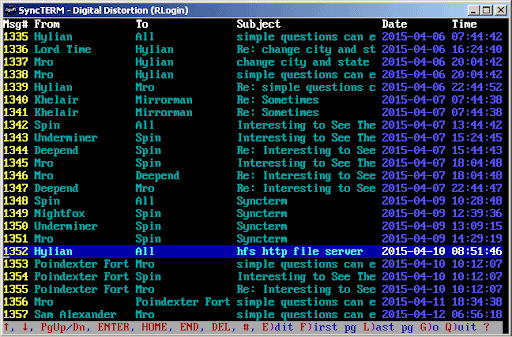
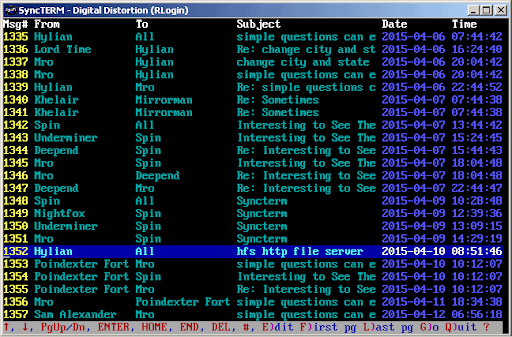
Being an Audio Forum Moderator, Part Two
This is the second in our series of articles giving a behind-the-scenes look at how a forum operates.
I will start this installment out by being perfectly honest: A forum moderator’s position is a frustrating, chaotic and thankless job for no pay, no benefits, not even a key to the executive washroom or a one-hour lunch. Staff gets cussed out, blamed for everything under the sun, taken advantage of, played against each other, and abused by private messaging or e-mail. For every time a moderator has to help out a member with a simple issue (like changing their e-mail address, fixing a typo, or assisting with the software), there are probably five or ten incidents having to deal with a membership run amok.
Some forum members feel it is a badge of honor to be asked to eventually join the staff. For a smaller forum, it can be enjoyable since there is so little to do. My oldest forum, in fact, has rarely seen an incident in the nearly 25 years it has been online. But once you have hundreds or thousands of members online during peak hours, all with their hundreds or thousands of different and oftentimes clashing personalities and attitudes, grab your weapon of choice (most often a keyboard, a mouse, and a stiff drink if you need one) and get ready for the onslaught.
New forum moderators quickly find out what their fellow members are really like. They observe the dark underbelly of the membership. They discover our habitual offenders who can’t control themselves, and then have to deal with the offenders directly. They soon learn to anticipate when problems will occur. They also learn, the hard way, what it’s like to have a member go ballistic on them when that member is called out for their behavior. Members they originally considered model forum citizens sometimes have a record about half a page long, full of warnings and reprimands.
A few months into it, they will sometimes wonder why they volunteered for the job, or why they desired that “Moderator” badge under their username. A couple of years into it, some moderators will quit or worse, disappear. They get disgusted. Burned out. Exhausted by it all. Some just want to be removed from the staff, and that is fine—we would rather have them enjoy the forum without having to deal with the craziness of moderation duties. Others just ghost us. They don’t log in. They don’t even respond to e-mails asking how they are.
All of us on the staff really do care how these missing staffers are doing. Working the front lines together, friendships are made. We never know why they left. Were they so distraught that they wanted nothing to do with the forums or anyone from them, including fellow staff? Did they just want a break to decompress? Did they have a serious health issue (or worse) that took them away from us? We never know. And we wonder.
Despite all the insanity, the nuttiness, the frustrations of being a moderator, there is a lot of camaraderie. Lifelong friendships are often made on forums, and some of the strongest of those friendships are with our fellow survivors in the moderation trenches, those who may have put in several years or well over a decade working alongside fellow troopers who volunteer for the cause day after day.
Despite the way a forum staff deals with members, nobody feels as though they are above any of the membership. (For those that approach the job with a “holier than thou” attitude, we find they do not last long in the role.) We’re human, just like the rest of the general public. It helps to keep that in mind when dealing with a forum’s staff when there is an issue we bring to their attention. We get frustrated. We’re busy and have too many things going. We’re forgetful or get distracted. Sometimes our personalities may clash, and there is no shame in handing off a problem to another moderator if we don’t feel a discussion is going well. Some troublesome members build a rapport with a moderator, and they can often work through issues efficiently together.
Just try not take it out on us, even though we may deserve it on rare occasion! I used to find some allegedly problematic members to be open to communication and cooperative, some even coming across completely different in private discussions than their public persona. The truly serious troublemakers (which are a very small percentage of a forum’s active membership) can be an issue but for the most part, members understand where they went wrong, even if they don’t always fully agree with it. When the staff is noncombative and humble about it, members are put at ease and realize that we are just as human as they are.
There are also special situations that arise. Sometimes that errant behavior has much deeper roots than we realize. We’ve had members who blurt out the first things that come into their minds, which often makes no sense in the context of the discussion; we’ve later found out they are on the autism spectrum. We’ve had members in good standing snap suddenly with little provocation—it turns out there are problems at home, like health issues, a breakup or divorce, or loss of a loved one. Some who sign up for multiple accounts may be bad at remembering usernames and passwords, rather than trying to circumvent issues they have had in the past. A good staff is human enough to realize that life sometimes happens, and members need a pass when they are having a rough spot in life. There are even a handful that will report themselves when they’ve stepped out of line. We wish we had more like them.
One comment we’ve heard over the years is that our members rarely see any problems and wonder why we sometimes have to make “corrective” posts either within a thread, or in a separate thread dealing with that behavior, or that we’ve had issues with a particular discussion they have been following. They usually don’t realize that we’ve already had to do quite a cleanup to a thread and have expended a lot of effort on it. Forum members do thank us for keeping the forums clean and likewise, it’s rewarding to know that our efforts have made a difference.
We do ask for a little tolerance. We sometimes get blamed for not catching a squabble within a thread or some inappropriate content we may have missed. The entire staff is not on the forum at all hours of the day, nor can they read every single post in every thread. The busiest forum I work with has over 200,000 new posts submitted per month. This is why a forum has a “Report” system—content can be reported to staff, who can then deal with it. It is much easier for the staff if these problems are reported through the Report system, rather than contacting an individual moderator—reporting it ensures that the entire staff is notified of the problem, and whoever is online can deal with it much faster.
Do moderators disagree with each other? Of course! Like any organization, a moderation staff is made up of individuals with different backgrounds, different beliefs and different styles of communication. Some member issues are easily dealt with. For more difficult issues, it is nice having our fellow moderators to bounce our thoughts off of so we can make the right decision. Some might be more willing to “swing the ban hammer” at a problem member, where others might see the issue in a far less severe light. Sometimes we’re unsure of what to do with a problem member, and we value our teammates’ input. We all keep each other in check.
One thing that assists us is our forum’s list of rules. These are not there just for the members—the staff uses them as a guideline for deciding what is, and is not, acceptable forum behavior. We hold a member’s behavior up against the published list of rules in order to determine the number of rules broken, and how severe the infraction is. (We will explore specific rules, and how we arrived at them, in our next installment.) Are we perfect in interpreting the rules? Of course not. Sometimes it appears as though we have a double standard—maybe one got off with a wrist slap for the same offense that we might have suspended another member for. Some rules are also not as serious as others. Some are just guidelines for how to write in the forum (such as, not writing in ALL CAPS BECAUSE IT IS CONSIDERED SHOUTING), where others cover behavior we do not allow in the forum (like racial slurs, personal attacks and posting spam).
Despite all the ups and downs, a good moderation team is proud of the work they do to maintain a smoothly operating forum. It isn’t anyone’s dream job by a long shot, but when problems are resolved efficiently, it’s satisfying to know you did your part to make the forum an enjoyable place for fellow members to participate in.
Now, it’s your turn! Have you had a question you have always wanted to ask a forum moderator? We’ll be picking some of the best questions from our comments and answering them in one of our future installments.
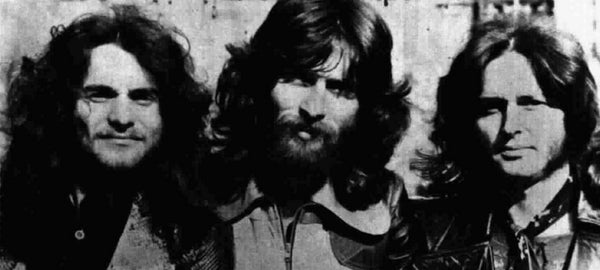
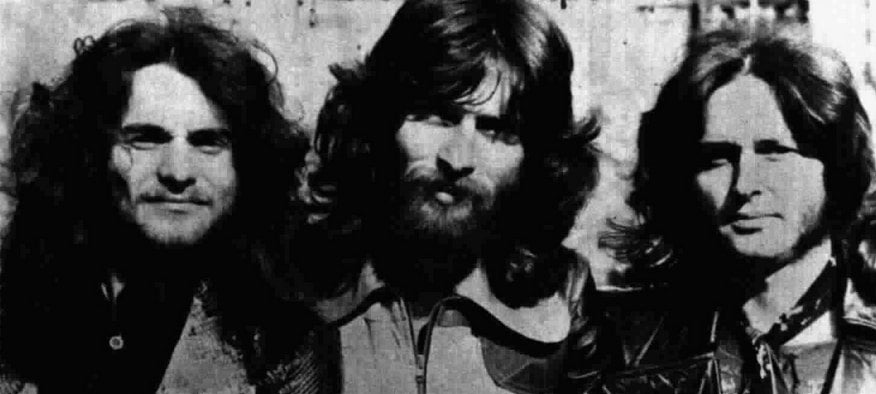
Italian Progressive Rock, Part Two: Le Orme
Le Orme (“The Footprints”) is one of the most successful and prolific of the Italian progressive rock bands. From their inception in 1966 through the last decade, they have continued to create compelling music (with a few stumbles along the way). Note: All translations from Italian are from Google Translate.
They released their first album in 1969, but from the cover art and sound you would think it was created several years earlier. The music is much more psychedelic than progressive, and the cover design is close enough to that of Cream’s Disraeli Gears to be considered an homage, if one wants to be charitable.
On this album, the group was a five-piece, with Aldo Tagliapietra on vocals, Antonio Pagliuca playing keyboards, guitarist Nino Smeraldi, bassist Claudio Galieti, and drummer Michi Dei Rossi. “Oggi verrà” (Today Will Come), from Ad gloriam (“To Glory”) gives you an idea of where they were at the time.
Prior to the recording of their second LP, Collage, Smeraldi and Galieti left the band. Vocalist Tagliapietra took over playing bass and acoustic guitar, and their new incarnation as a trio would continue through the next three studio releases, earning them comparisons to Emerson, Lake & Palmer. Everything about Collage was a big departure from their psychedelic roots, including a change to major label Philips. Noted Italian composer and producer Gian Piero Reverberi was brought in to oversee the recording. The title track sounds a lot like an ELP fanfare.
The album reached the top ten on the Italian charts and garnered a fair amount of radio play. The song “Sguardo verso il cielo” (Look to the Sky) was quite popular, as the audience reception to this Italian television performance with orchestral backing clearly shows (I am assuming the pianist is Reverberi):
It remains one of their most iconic compositions, as demonstrated by this live performance from 2010 (with drummer Carlo Bonazza and guitarist Tolo Marton):
Collage was followed by Uomo di pezza (“Ragman”), which hit number one. Producer Reverberi added piano on one track. Here’s “La porta chiusa” (The Closed Door), a typical cut from that album:
At this point, they were already considered one of the premier Italian progressive bands. A 1972 tour found them performing along with Peter Hammill (of the British progressive group Van Der Graaf Generator). Hammill’s label Charisma took an interest in Le Orme, and they wound up recording an English-language version of their next record, Felona e Sorona, for release outside of Italy. Hammill, himself, translated the Italian lyrics that told a tale of two planets (Felona and Sorona) whose mood and fate alternated between happiness and sorrow, depending upon whether they had the attention of a supreme being.
Felona e Sorona is widely considered their masterpiece and an essential addition to any progressive rock collection. This link gives you the full album, but you can choose individual tracks in the right-hand column:
To capitalize on their popularity as a live act, they released In Concerto in 1974, with a 22-plus-minute track called “Truck of Fire.” The album was not well recorded, and the first 17 minutes are comprised of a rather intense, noisy, chaotic jam complete with a long drum solo, so I’ll spare you this one.
On their fifth album, Contrappunti (“Counterpoints”), producer Reverberi briefly became a member of the band, playing piano. The title track is, again, very reminiscent of ELP once it gets going:
“La fabbricante d’angeli” (The Manufacturer of Angels) is another fine cut from the album:
The next album represented big changes for the group. They went to Los Angeles to record 1975’s Smogmagica, and added a guitarist, Tolo Marton, to the band. The cover art was done by painter Paul Whitehead, whose work has graced album covers for Genesis, Peter Hammill, and Van Der Graaf Generator, among others. Reverberi continued as producer, but did not play on the record. Smogmagica had a somewhat more commercial rock sound, and was not as well received as the previous few albums. Nonetheless, two tracks are among my favorites. Here’s the rocking “Los Angeles”:
“Laserium Floyd” lives up to its name as a dreamy, spacy instrumental:
Verità nascoste (“Hidden Truths”) was their seventh studio album, marking a return to their earlier style. Guitarist Tolo Marton had left the band before this recording. He was replaced by Germano Serafin, who would continue as a member for the next three albums. The title track even utilizes a string quartet. “Insieme al concerto” (Together at the Concert) kicks off the record with all the hallmarks of classic Le Orme enhanced by Serafin’s electric guitar:
“Regina al Troubadour” (Regina at the Troubadour) features some well-controlled electric guitar feedback near the end:
Storia o leggenda (“History or Legend”) features the same lineup as Verità nascoste, along with strange cover art by the same people who had done Uomo di pezza. The album has two very different moods. The music on the first side is a mostly lighter, almost wimpy, version of their classic sound. Here’s the title track:
Side Two is something else entirely. New sounds and off-kilter rhythms show up throughout. “Se io lavoro” (If I Work), which leads off the second side, is propelled by sequenced synthesizer riffs that are highly reminiscent of the work of Jean-Michel Jarre (Oxygène) or Ray Lynch (Deep Breakfast).
“Al mercato delle pulci” (At the Flea Market) yo-yos between Philip Glass-like percussion and heavy, ominous guitar, bass, and drums.
Le Orme moved in yet another direction for 1979’s Florian, their ninth studio release. Predating the “Unplugged” phenomenon, they went all-acoustic for this one. There were no personnel changes, but the addition of violin and cello to their instrumental arsenal (as well as the return of Gian Piero Reverberi as co-producer and engineer) resulted in a completely different sound. The instrumental title track clearly demonstrates their versatility.
Piccola rapsodia dell’ape (“Little Bee Rhapsody”) from 1980 sounds a lot like Florian with a touch of the first side of Storia o leggenda. Missing again are the heavy keyboards and guitar. Guitarist Serafin would leave after this release. “Fragile conchiglia” (Fragile Seashell) is typical of the album.
Despite having reverted to their original lineup as a trio, the sound of 1982’s Venerdi (“Friday”) bears little resemblance to what came before. They were obviously going for a less progressive, more new wave style. Several tracks even use electronic drums. This lip-synched TV performance of “Marinai” (Sailors) is almost embarrassing in light of what they had done in the past (but don’t they look stylish!):
I have to admit that it’s rather catchy the second time through, but it’s not what their fans were hoping for. The trio broke up after this album, and briefly re-formed in 1986, but the next album wasn’t released until years later.
1990’s Orme was, sadly, a continuation of their flirtation with new wave stylings and lightweight pop compositions. The trio was augmented by a number of musicians and vocalists. “L’indifferenza” is typical of the tracks on Orme:
Toni Pagliuca left the band and was replaced by two keyboardists, Michele Bon and Francesco Sartori, for Il fiume. Bon had been one of the supplemental players on the last album, and he plays a mean guitar synth. Thus began a resurgence of sorts, with this record and the next two (not counting 1997’s Amico di ieri – an album of re-makes of earlier songs) forming a trilogy of sorts. Il fiume was released in 1996, and the band came to America for a few gigs. I saw them perform in the basement of Johnny Foley’s Irish Pub in San Francisco, a most unlikely venue, and they were quite good. The entire album is linked here:
Elementi featured cover art once again by Paul Whitehead. Keyboard player Sartori was replaced by Andrea Bassato, who also plays violin. The album is broken up into four parts, representing wind, earth, rain, and fire. Each part begins with an “element dance.” The opening track, “Danza del vento” (Wind Dance) starts with a synthesizer blast straight out of the ELP tone book:
The third album in the trilogy, L’infinito, finds the four members augmented by a chorus and a string quartet. As before, Paul Whitehead provides the cover art. The title track has a heavy, orchestral feel:
“Si puo’ immaginare” starts out soft and sweet, but builds to a rousing finale:
2011’s La via della seta (“The Silk Road”) is the first Le Orme album without singer and bassist Aldo Tagliapietra, who retired in 2009. With one original member left, drummer Michi Dei Rossi, the band continued with Michel Bon and new bassist Fabio Trentini. Others on the recording are guitarist William Dotto and keyboard player Federico Gava. Still in need of a lead vocalist, they recruited Jimmy Spitaleri from the band Metamorfosi to sing on the album and in live performances. Although Spitaleri’s strong voice is deeper than Tagliapietra’s, it works well with the sound of the band, as evidenced in the title track:
The instrumental “Serinde” opens with a very Asian feel, then moves into more familiar Le Orme territory:
In 2016, the trio of Bon, Dei Rossi, and Trentini revisited Felona e Sorona. They re-recorded the entire album as a double, in both Italian and English, with Trentini providing the vocals. His singing is closer to the sound of Tagliapietra than Spitaleri. The redone versions are reasonably faithful to the originals, except for the addition of some extended instrumental sections and an unnecessary drum solo in the first track. Personally, I’d stick with the first release.
One year later, Dei Rossi alone put together Classic Orme, a third re-imagining of tracks from various albums, this time with classical arrangements (by Dei Rossi himself). Strings, flute, trombone, percussion, and keyboards provide the instrumentation, and vocals are courtesy of tenor Eero Lasorla and soprano Marta Centurioni. Not being a fan of classical/operatic singing, this one doesn’t work for me. (There do not appear to be any samples on YouTube.)
2019’s Sulle ali di un sogno might be a new record (in two senses). Yet again, Dei Rossi and Bon team up for a run through previously released songs, this time with new guitarist Ivan Geronazzo and bassist/vocalist Alessio Trapella. David Cross (of King Crimson) contributes violin on a number of tracks, and Lasorla and Francesca Michielin provide vocals on one song each. The end result is mostly a blend of the sound of Classic Orme and the other acoustic albums. Here’s Trapella singing on the title track (one of the few with electric instruments):
Michielin does a nice vocal turn on “Gioca di Bimba,” originally from Uomo di Pezza:
In the next installment of Italian Progressive Rock, you’ll get a brief introduction to a few of the other great Italian bands from the 1970s. I’ll leave you with Le Orme’s smoking concert performance from 2005 in Pennsylvania. The lineup is Dei Rossi on drums, Tagliapietra on vocals, bass and 12-string, with Bassato and Bon on keyboards. This is where you’ll see and hear Michele Bon’s incredible chops on the guitar synth:
Header image courtesy of Wikimedia Commons.
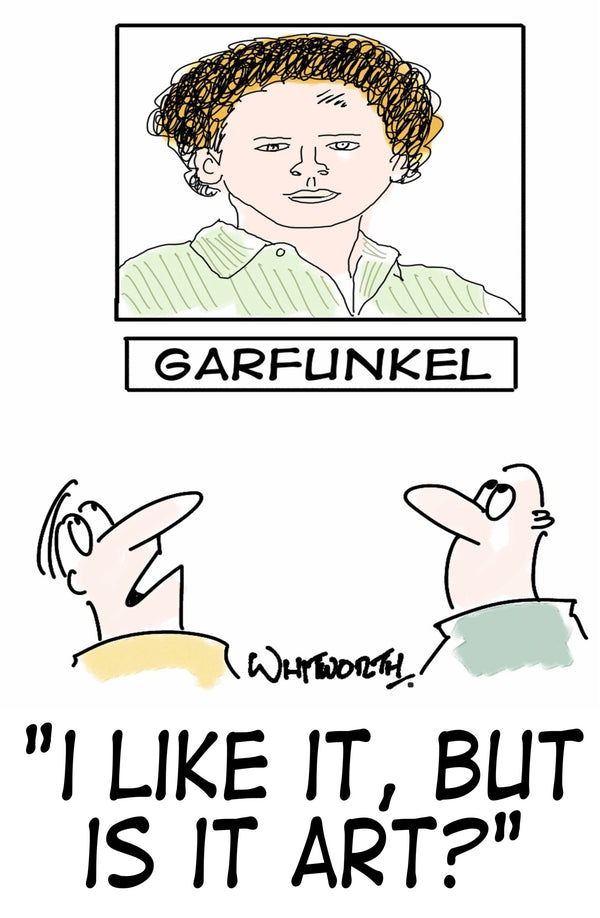
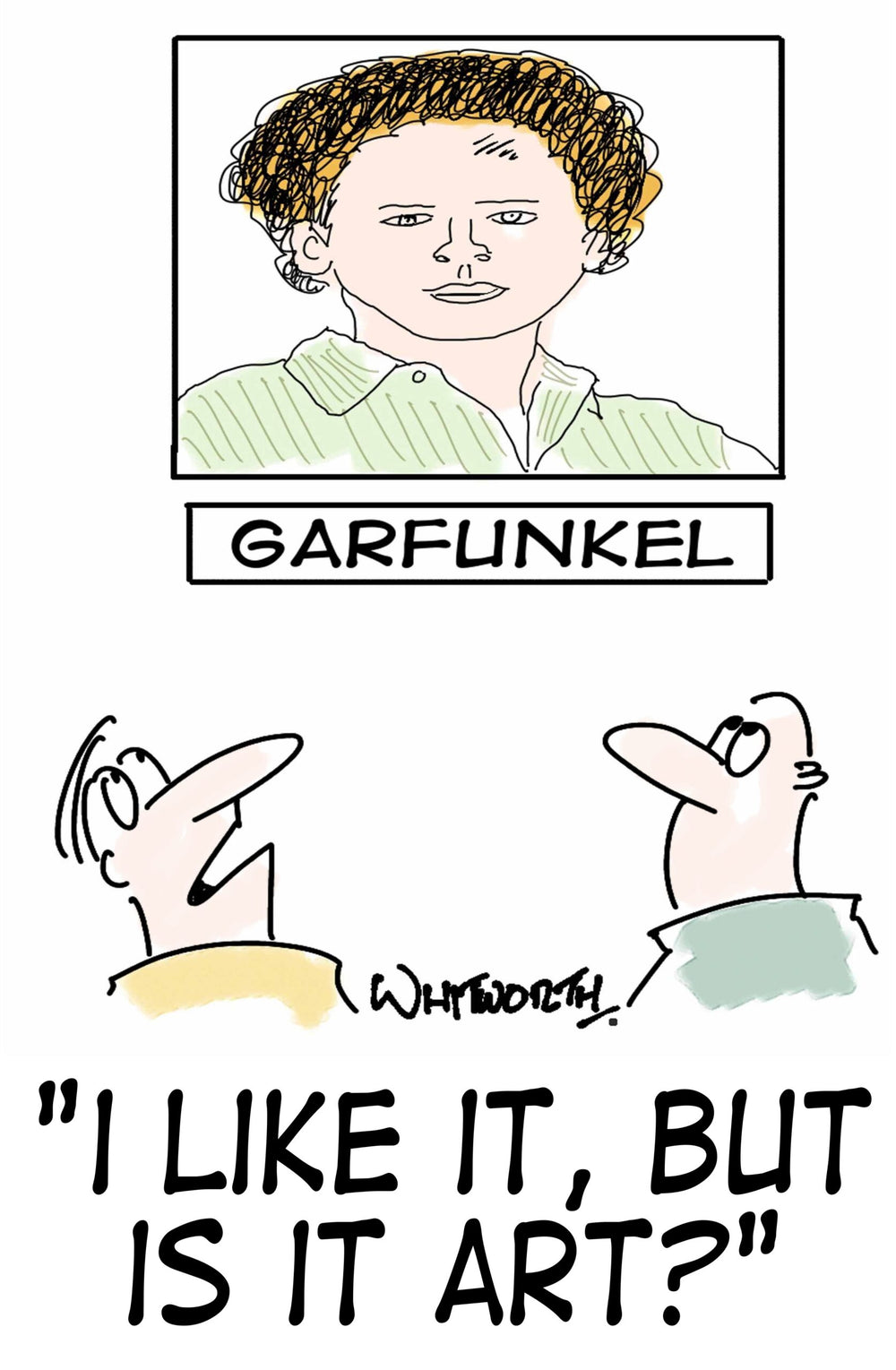
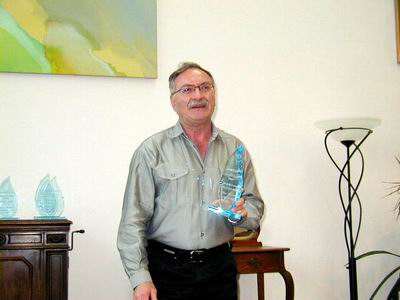
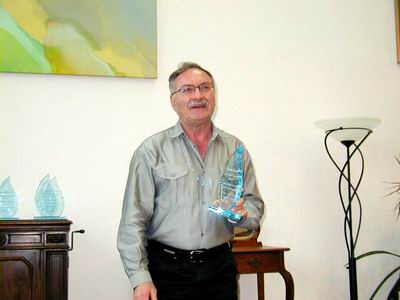
In Memoriam: Victor Goldstein
The audio world lost one of its most pre-eminent, wonderful, colorful, passionate people with the passing of Victor Goldstein on May 5. I got to know him well over the decades and his loss at age 75 (age unconfirmed as of this writing) hits especially hard, since he’s the first friend of mine to lose their life from COVID-19.

At various times Victor and his high-end audio distribution/importing company Fanfare International handled Bowers & Wilkins speakers, Jadis and Audiovalve tubed electronics, Harmonix system-enhancement devices and others. Victor was unmistakable – well-dressed, cultured, exuding old-world charm. He spoke seven languages fluently. He had masters degrees in nuclear science and mechanical engineering. Of Romanian descent, he had a distinctive accent that Stereophile/Analog Planet editor Michael Fremer and I could not (and still can’t) resist imitating, especially since Victor would often preface his sentences with, “I must tell you!” followed by his expressions of unbridled enthusiasm for whatever audio component, recording, concert or restaurant he’d just experienced. “I must tell you! You will not believe the sweetness, the exquisite tone of this amplifier!” “I must tell you – listen to the violin when I play this track – simply magnificent!” Michael and I got to the point where we could not have a conversation with each other without prefacing it with, “I must tell you!” in Victor’s accent. At one audio show Victor approached Michael and it went something like, “Michael Fremer! I understand you’ve been impersonating me! May I hear it?” in that Bela Lugosian manner. Michael couldn’t resist – and not only did Victor take it in typical good humor, they had a “dueling Victors” conversation which cracked up everyone around them. This became a ritual at shows and industry events. Victor was a perfectionist when it came to audio system setup. As former right hand man Scot Markwell notes in his moving tribute in The Absolute Sound, Victor was known to have exceptional hearing. It could be intimidating – when it came to aural judgments, you could not bulls*it the man but if he approved of a setup, you knew it was right. As our Jay Jay French notes, “I met Victor when [owner] Mike Kay introduced us when working at Lyric HiFi in 1995. He was always excited to talk audio.” The first time Michael Fremer and I visited him in his Upper East Side Manhattan apartment (we were both working for TAS at the time), I was intimidated by the elegant neighborhood and the apartment’s furnishings. Victor and his pediatrician wife Judy weren’t scuffling. But Victor put us immediately at ease before ushering us into his listening room, which was immaculate and featured B & W speakers and, if I remember correctly, Jadis electronics. He carefully selected a record and lovingly (there’s no other way to describe it) placed the record onto the turntable. He went through a ritual of cleaning the record and the stylus. “You must excuse me. I have to do this for every record. I am a perfectionist about these things. I cannot do it any other way.” He carefully cued up the record – and it was magnificent. Beautiful, sumptuous, inviting sound, yet checking all the audiophile boxes – imaging, soundstaging, detail resolution, dynamics. At one point he played a Decca LP (DL710106) of Ruggiero Ricci playing the Paganini Concerto No. 2 in B Minor, Op. 7 (“La Campanella”) with Max Rudolf and the Cincinnati Symphony Orchestra. Victor was passionate and deeply knowledgeable about classical. But before he did, he gave a little speech, something like, “I want you to listen to the beauty, the tone, the exquisiteness of his violin playing. You have never anything like the sweetness – this is an amazing recording.” He was right. We were dumbfounded. The playing and sound were heart-stopping. Years later I found a copy of that record. I never look at it without thinking of Victor.
Back in the mid-1980s when I first met Victor, hi-fi journalists were not exactly models of sartorial splendor. Stereophile founder Gordon Holt would attend shows in ripped jeans, old sneakers and thrift-shop shirts. Reviewers would go to shows wearing sweat pants, T-shirts that had seen better days and shoes that wouldn’t be fit to donate to a thrift shop. Not Victor. He always looked elegant, often wearing jackets and suits, beautifully tailored. You’d never see him in ratty attire, even when he and his assistant Frank Garbie would come out to The Absolute Sound to set up heavy amplifiers.
He was a bon vivant in the true sense – he knew his restaurants, food and wine. One night he took myself and TAS staffers Michael and Sallie Reynolds, then managing editor, to dinner at Le Cirque in Manhattan. This middle-class Long Island boy had never been to anything like it. Sitting at the next table was Robin Leach of the then-hit TV show Lifestyles of the Rich and Famous! Naturally I had no knowledge of the wine and the food was an exotic adventure. Seeing I was out of my league (my culinary tastes ran more to Jack in the Box), Victor was so kind and gracious in guiding my choices.
As you can imagine, the food, the entire experience, was sensational. After the wine started flowing, Michael, a very fine and funny impressionist, started impersonating Leach – an easy target considering his pompous over-the-top delivery on the show. The more Leach made a show of not paying attention, the louder Michael got, to the amusement, then chagrin of the rest of us. (Leach never did acknowledge us.) I’m laughing out loud remembering this. Good times, Victor!
I saw Victor many times over the decades at audio shows and events, and every time he had a warm welcome. Once, after we’d lost touch for a number of years, he saw me and said, “you look great!” I shook the lapels of my jacket and replied, “Men’s Wearhouse! $24.95!” Last year at the New York Audio Show we both happened to be in the Andover Audio room at the same time. Andover was showing their Model One, a compact, all-in-one audio system with turntable and I was amazed at the sound coming from this modest rig. I looked at Victor and tentatively asked, “Does that sound as good as I think it does?” He replied, “This is a fantastic little system! This would be perfect for someone who wanted good sound that would fit into a small space!” Even after decades of hearing hundreds of systems, I still looked to Victor for validation.
The last time I saw Victor, at CanJam NYC 2020, was, in retrospect, bittersweet. By coincidence we would up having exhibitor booths right next to each other, so we got to spend an entire two days together, more time than I had had to talk to him in decades. We both commented on how nice that was, and as you can imagine, spent a lot of time reminiscing about the Good Old Days. As usual, Victor was representing some top-notch-sounding gear, in this case Audiovalve. At one point, completely unprovoked, Victor stuck out his arm, pointed to his upper arm and said, “feel that!” Taken aback, I said, “What?” “Feel that!” So I did. His upper arm was like a rock. “Holy crap! How do you stay in such good shape?” “I work out!”
It’s hard to believe that someone so vigorous, so passionate, so thoughtful is no longer with us. We will miss you Victor. And I hope you don’t mind if we do an impression of you every now and then. You certainly left an impression on us.
Postscript: Our Robert Heiblim also knew Victor and shares his memories here.
My dear friend and advertising agency owner Mike Racz was also a good friend with Victor. Together, we often had a dining “club,” as we worked expense account dinners in plying the audio press to review and cover our goods. At that time I was with Denon.
We had many fine and memorable meals and conversations over the period, and we often compared meals in the same way we compared audio components, all in fun and admiration. Victor had invited us to a restaurant I believe was called something like Vienna 1873 (though I may have this wrong) an Austrian spot. Very fine food and an excellent veal as I recall.
As we were considering the meal and the service, Victor declared that we simply could not compare fine Italian restaurants (and we had dined at many and I remain friends with some of the proprietors) due to the fact that it was simply “unfair.” As he put it, “what they can do with just a chicken and sauce is too hard to compete with,” so he insisted they had to have a separate ratings scale.
Too funny really, and he was quite sincere, as he was with all his beliefs. He was also generous in his views and respectful of all other opinions, even when he did not share them. A marvelous man.
Header image courtesy of Stereo Times.
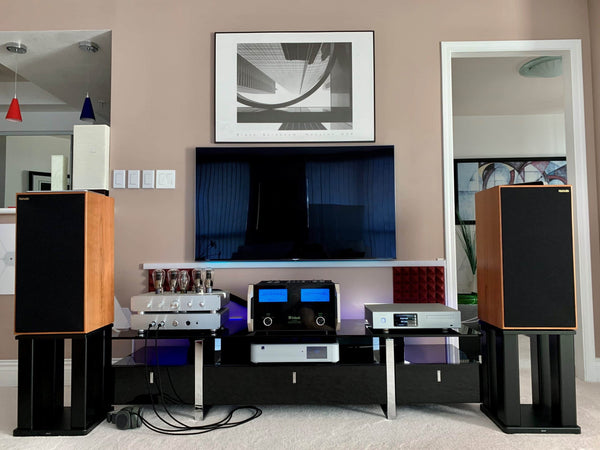
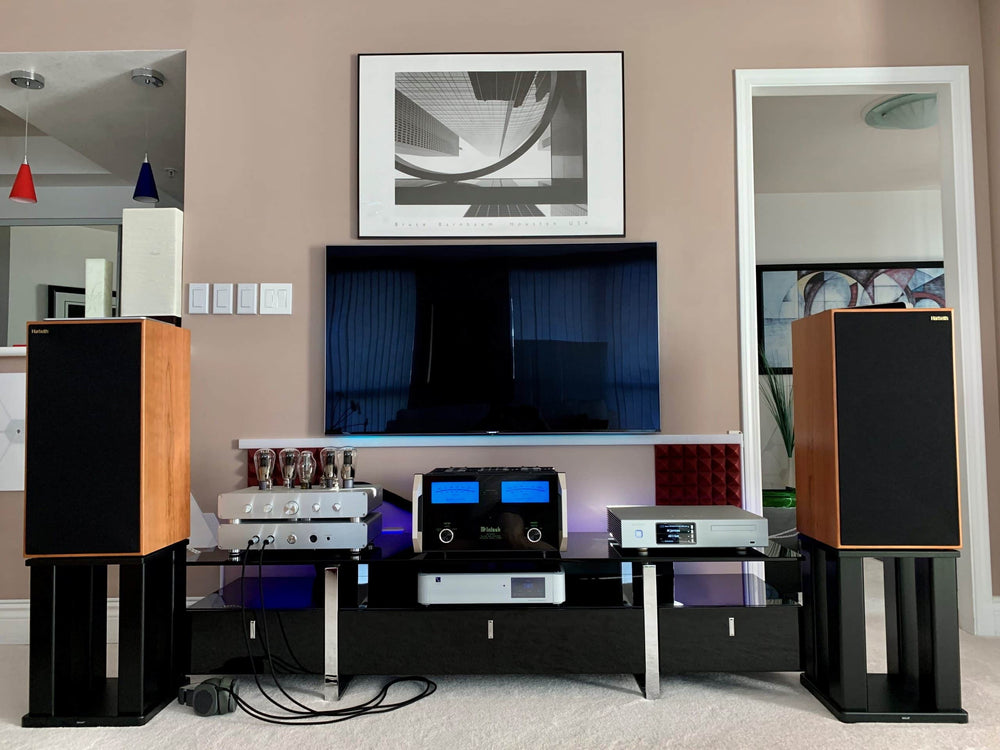
Multichannel Hall of Fame Mk II
(Last time we offered overviews of several recording labels that led the way to a glorious high-res, multichannel future for classical music. Some persevered, some did not. Here’s the rest of the story.)
William Lawes: The Royal Consort. Phantasm. Linn CKD470, 2015. Two Hybrid SACDs (5.1, 2.0 mixes). Phantasm is a viol consort led by Baroque scholar Laurence Dreyfus, joined on this recording by theorbist Elizabeth Kenny and organist Daniel Hyde. Lawes (1602–45) is not as well-known as some of his contemporaries, so Dreyfus fills us in:
This is one of the greatest collections of ensemble dance music ever composed. In it one finds 10 “Setts” or suites of dances boasting a range and depth of expression on a par with Dowland’s Lacrimae, J. S. Bach’s orchestral suites, Rameau’s orchestral dances, even the waltzes of Johann Strauss, Jr. . . In every sett there are astounding moments that excite both mind and body.
Even though they’ve stopped releasing SACDs, I am honoring Linn Records and producer-engineer Philip Hobbs with a spot in this list. By 2015 Phantasm had already made a fine Dowland Lachrimae. But the Lawes discs contain a wider variety of music, composed with a degree of individualism that Dowland, undoubtedly the “greater” composer, had largely forsworn. Dreyfus speaks eloquently on this point too:
It is not that the music is merely showier than normal dance music, but that Lawes composes his parts as if the performing musicians are themselves dancing. Rather than music to accompany actual dance, the Royal Consort [takes on] the varied gestures and vivid movements that we yearn for in dance. [The dancers’ imagined bodies] engage each other with an intricacy and passion exceeding the most sophisticated choreography of the day.
Once you hear a sett or two or three, you’ll know what he’s talking about. Several live performances by Phantasm of this music are available on YouTube, among them this lively Fantazy à 5 “to the Organ,” which is also on the album:
For more from Linn, try the Avison Ensemble’s complete Corelli series, an absolute joy.
Early Romantic Horn Sonatas. (Music of Ries, Danzi, von Krufft.) Steinar Granmo Nilsen, natural horn; Kristin Fossheim, fortepiano. 2L–113–SABD, 2015. Blu-ray Pure Audio plus hybrid SACD (5.1, 2.0 mixes).
Morten Lindberg emphasizes Norwegian artists and the very special (big, high-ceiling) interiors he likes for recording. I’ve featured his records often. He’s got a more identifiable house “sound” than anyone else still doing multichannel. He believes that
It is not our task as producers and engineers to try to re-create a concert situation with all its commercial limitations. On the contrary, we should make the ideal out of the recording medium and create the strongest illusion, the sonic experience that emotionally moves the listener to a better place.
Nilsen and Fossheim are scheduled to release another album in 2020. Meanwhile, check out Trachea, Lux, or Woven Brass.
Fauré: Piano Music. Nicolas Stavy. BIS–2389, 2018. Hybrid SACD (5.0, 2.0 mixes).
BIS Records was founded in 1973 by Robert van Bahr. Based in Åkersberga, Sweden, it is the leading Scandinavian classical label, continuing to release well-produced SACDs nearly every month. BIS has also adopted eco-sensitive packaging (It’s more durable! And easier to shelve!).
If you are unfamiliar with Fauré’s piano output, Nicolas Stavy’s selection provides a fine introduction. It ranges from the hitherto unpublished Sonate, N. 5 (1863), a student work written in frank imitation of earlier masters, to the towering Nocturne No. 6 in D Flat Major (1894), itself the work of a master. Stavy plays with enormous sensitivity and conviction; engineering was done by Take5, a globetrotting production outfit born at BIS.
I have lots of BIS recordings, including Maasaki Suzuki’s 55-volume set of Bach Sacred Cantatas. I also treasure my assortment of Aho and Pettersson symphonies, not to mention one-offs like Christian Lindberg’s Bernstein potpourri from Liverpool, easily one of the centenary’s best. When a label’s standards are as high as they are in Åkersberga, you really can “sit back and enjoy.”
Bach: Christmas Oratorio. Netherlands Bach Society, dir. Jos van Veldhoven. Channel Classics CCS SA 20103, 2003. Two hybrid SACDs (5.0, 2.0 mixes) plus 192-page program book.
If I had to choose just one Channel Classics recording for my desert island, it would be this one. That’s partly because of the lavish program book, compiled with the generous assistance of the Museum Catharijneconvent, Utrecht. The visual art that graces it is both diverse and stylishly presented. Along with the discs’ duo-fold ecopak, the book is fitted into a deep-red velvet box that could sit handsomely on your shelves for at least a half-century.
The performance, like the packaging, is definitely not generic. Veldhoven and his crew made every note of these six linked cantatas their own. Some of it you’ll love immediately, some of it perhaps not. Producer-engineer C. Jared Sacks made it all glisten, though, including what you’ll take to be a lovely Baroque-church acoustic (it was actually recorded at Muzeikcentrum Frits Philips in Eindhoven).
(Above, not the Christmas Oratorio but some very Christmassy Bach from the Netherlands; click here to learn more about the NBS’s ongoing “All of Bach” video project.)
I’ve devoted a lot of space over the years to other CC artists, including Rachel Podger, Iván Fischer, and the Amsterdam Sinfonietta. Thanks again, Jared.
Dvořák: Symphony No. 8 (w/ Janáček: Symphonic Suite from Jenůfa). Pittsburgh Symphony Orchestra, Manfred Honeck. Reference Recordings FR–710SACD, 2014. Hybrid SACD (5.1, 2.0 mixes).
I picked this almost at random from six or eight such Pittsburgh SO discs. They’re all good. Honeck is a master of the Central European repertoire (e.g., Beethoven, Dvořák, R. Strauss, Bruckner), as on these “fresh! from RR” live recordings. Dirk Sobotka, John Newton, and others from Soundmirror have handled the engineering work, consistently first-rate. These are heat-of-the-moment readings, not “documents.” When they’re hot, they’re hot. From take-off to landing, you’re there at Heinz Hall.
I could summarize the whole Reference Recordings story here, but you undoubtedly know big chunks of it already. (For more, click here.) They’re still going all-out to provide quality classical multichannel, to which they’ve added quality downloads and a new format, HRx. Live long and prosper, folks.
(Above, Dvořák’s Eighth, with Honeck but not the Pittsburgh SO; oh well! See you in two weeks.)
(Header image: Charles I in Three Positions, by Sir Anthony van Dyck, 1635; Charles was the lifelong patron of William Lawes, who was shot to death by political enemies of the Royalists at Rowton Heath, near Chester. The King instituted a “special mourning” for the man he called “Father of Musick.”)

